Decor
Luxury Living: What is a Penthouse Explained

Welcome to our comprehensive guide on luxury living! This piece will take you through the lavish world of penthouses, delving into why they represent the ultimate in luxury. So, what is a penthouse, you might wonder? Let’s discover together.
A penthouse is generally defined as the top floor of a building, characterized by privacy, spacious square footage, and unobstructed views. However, the definition of a penthouse has evolved over time to encompass much more. Originally, penthouses were separate units on the rooftop of apartment buildings, often used to house the live-in help of wealthy residents. But as developers recognized their value, penthouses started transforming into desirable residences with premium prices.
In the modern era, penthouses can encompass the top floor or multiple floors of a building. Each unit offers unique amenities, such as private pools, roof decks, and top-of-the-line finishes. Despite their luxurious features, penthouses may also have drawbacks, such as leaks and potential disruptions from high winds. Nonetheless, penthouses remain highly coveted and synonymous with luxury living.
Key Takeaways:
- A penthouse is the top floor of a building, offering privacy, spacious square footage, and unobstructed views.
- Originally used for live-in help, penthouses have evolved into highly desirable residences with premium prices.
- Modern penthouses can encompass multiple floors and offer unique amenities like private pools and roof decks.
- Penthouses may have drawbacks such as leaks and potential disruptions from high winds.
- Despite the drawbacks, penthouses remain highly desirable and synonymous with luxury living.
The History of the Penthouse
In the early 20th century, penthouses were built as separate units on the rooftop of apartment buildings in Manhattan. These rooftop units were primarily intended for live-in help and served as a solution to the limited space in the rapidly growing city.
As time passed, the top floors of buildings underwent a transformation. Some were divided into smaller living units, accommodating the increasing demand for housing, while others were repurposed as amenities like gyms.
However, developers soon recognized the value of top-floor units and the potential for privacy and breathtaking views they offered. This realization led to a shift in mindset, with premium pricing reserved for these exclusive penthouse spaces.
“The view from a rooftop penthouse is something you can’t find anywhere else. It’s a luxury that’s hard to put a price on.” – Real Estate Expert
By the early 2000s, the concept of penthouses underwent a dramatic evolution. These luxurious residences began to increase significantly in size, often spanning entire floors of a building. With expansive square footage and unparalleled amenities, penthouses became synonymous with the epitome of luxury living.
| Era | Key Developments |
|---|---|
| Early 20th century | Rooftop units primarily for live-in help |
| Mid-20th century | Conversion to smaller living units or amenities |
| 1980s | Recognition of value and premium pricing |
| Early 2000s | Significant increase in size and luxury offerings |
Through the years, penthouses have undergone a remarkable transformation. From humble beginnings as rooftop units for live-in help, they have evolved into sought-after residences that define luxury.
Penthouses in the Modern Era
In today’s market, modern penthouses have become synonymous with luxury living. These exclusive residences can encompass the top floor or multiple floors of a building, depending on the architectural design. Luxury buildings often designate several units as penthouses to highlight their distinction in terms of views, amenities, and square footage.
Architecturally, some penthouses are set back from the rest of the building or face different directions to offer unparalleled privacy and unique perspectives. Others span multiple floors, creating duplex or triplex units that provide expansive living spaces. The common thread among all penthouses, regardless of their design, is their recognition as the most desirable and highest quality residences in a building.
The distinguishing features of modern penthouses include:
- Larger square footage
- Higher ceilings
- Floor-to-ceiling windows
- Luxury amenities such as private pools, roof decks, and wine rooms
- Top-of-the-line finishes and appliances
These luxurious elements create an elevated living experience that is unmatched in other units of the same building, making penthouses the pinnacle of luxury living.
Example of a Modern Penthouse Floor Plan:
| Floor Level | Square Footage | No. of Bedrooms | No. of Bathrooms | Amenities |
|---|---|---|---|---|
| Top Floor | 3,500 sq ft | 3 | 3.5 | Private Pool, Rooftop Terrace, Wine Room |
| Lower Floor | 2,800 sq ft | 2 | 2.5 | Home Theater, Home Office, Gym |
As seen in the example floor plan above, modern penthouses offer spacious square footage, allowing for luxurious living and ample space for entertaining. The multi-level layout provides separate areas for relaxation, work, and recreation, ensuring a seamless blend of functionality and sophistication.
The allure of modern penthouses is further enhanced by their prime location within luxury buildings, offering panoramic views and unparalleled exclusivity. Whether it’s the breathtaking city skyline or sweeping ocean vistas, penthouse residents can savor the beauty of their surroundings from the comfort of their private haven.
Living in a modern penthouse is a testament to the height of luxury and sophistication. With their expansive square footage, top-notch amenities, and stunning views, these residences redefine what it means to live in the lap of luxury.
So, if you’re looking for the epitome of luxury living, a modern penthouse is the ultimate choice.
Penthouse Amenities
Penthouse living offers a myriad of amenities that set these exclusive residences apart from other units in the same building. With their spacious square footage and luxurious offerings, penthouses provide an elevated living experience.
In addition to their larger square footage, penthouses often feature higher ceilings, measuring at least a foot and a half higher than regular units. This architectural feature adds a sense of grandeur and creates a more open and airy feel.

Floor-to-ceiling windows are a hallmark of penthouse living, providing breathtaking views and flooding the space with ample natural light. These expansive windows not only offer stunning vistas but also create a seamless connection between the indoor and outdoor spaces, blurring the boundaries and maximizing the enjoyment of panoramic views.
The luxury offerings in penthouses are second to none. Private pools, roof decks, and terraces provide exclusive outdoor spaces for relaxation and entertaining. These outdoor areas become an extension of the living space and offer a sanctuary in the midst of the bustling city.
Inside the penthouse, you’ll find a wealth of amenities designed to cater to your every need. Wine rooms, libraries, and fireplaces create a cozy and inviting atmosphere, perfect for unwinding and entertaining guests. The finishes and appliances in the kitchens and bathrooms are top-of-the-line, exemplifying the highest standards of luxury.
In summary, penthouse amenities go above and beyond traditional residential offerings. From the extra square footage and high ceilings to the breathtaking views and luxurious finishes, penthouses truly epitomize the epitome of luxury living.
Drawbacks of Penthouse Living
Despite the luxuries and prestige of penthouse living, it’s important to consider the limitations and drawbacks that come with it. While penthouses offer unparalleled views and exclusive amenities, they are not without their challenges.
One common issue that penthouse residents may face is the susceptibility to leaks. Due to their location directly underneath the building’s roof, penthouses can be more prone to leaks and water damage compared to units on lower floors. This can be a significant inconvenience and may require frequent maintenance to address any potential issues.
Another drawback of penthouse living is the impact of building height limitations. Super-tall buildings can experience high winds at greater heights, and these winds may be felt more strongly on the topmost floors. As a result, outdoor space usage in penthouses may be limited or affected by strong gusts of wind, making it less enjoyable to fully utilize balconies or terraces.
In addition, the high demand for penthouse living can lead to longer wait times for elevators, especially during peak hours. The limited number of penthouse units in a building means that more residents may be vying for the same elevator space, which can cause delays and inconvenience for those residing on the higher floors.
Furthermore, the height and location of penthouses can sometimes result in less reliable cell phone reception. The construction materials and positioning of the penthouse unit within the building may hinder the strength of cellular signals, leading to potential difficulties in making and receiving calls.
It’s important for potential penthouse residents to carefully weigh the benefits of luxury living against these potential drawbacks. Consideration should be given to the lifestyle preferences and priorities of each individual before making a decision.
| Drawbacks of Penthouse Living | Considerations |
|---|---|
| Susceptibility to leaks | Frequent maintenance and potential water damage |
| Building height limitations | Potential limitations on outdoor space usage due to high winds |
| Longer wait times for elevators | Inconvenience during peak hours |
| Less reliable cell phone reception | Potential difficulties in making and receiving calls |
It’s essential to be aware of these drawbacks and carefully consider them before committing to penthouse living. The decision should be based on personal preferences, lifestyle needs, and the ability to mitigate any potential inconveniences.
The Modern Definition of a Penthouse
The traditional definition of a penthouse as the top-floor unit of a luxury residential building has evolved. Nowadays, the term “penthouse” is often used as a marketing term to describe a unit with unique features and amenities that set it apart from other units in the building. This can include different layouts, higher ceilings, and ample outdoor space. It’s no longer necessary for a penthouse to be on the top floor; instead, it is defined by its distinctiveness within the building. This changing terminology can sometimes help real estate agents sell apartments for higher prices but can also be confusing for buyers navigating the market.

To provide a clearer comparison between the different terminologies and designations used in the real estate market, we have created a table showcasing the distinguishing features of each:
| Terminology | Description |
|---|---|
| Triplex Penthouse | A combination of an original penthouse and a massive duplex, creating a multi-level living space. |
| Sky Loft | A unique unit marketed with distinctive features, often abandoning the term “penthouse” altogether. |
This table highlights the different terminologies used in the market to cater to the evolving preferences of buyers. Real estate developers and agents strive to showcase the exceptional features and unparalleled luxury of these distinctive living spaces.
The Best Unit Isn’t Always the Top Penthouse
Contrary to popular belief, the best penthouse unit in a building is not always the one on the top floor. While the term “penthouse” traditionally connotes the highest unit in a building, there are various factors that can make other penthouse units more desirable and sought after.
One such factor is the availability of larger terraces. Penthouse units with expansive outdoor space provide the opportunity for residents to enjoy al fresco dining, host gatherings, or simply relax while taking in the surrounding views. These larger terraces offer a unique outdoor living experience and add a sense of luxury and exclusivity to the penthouse.
Additionally, unobstructed views can significantly enhance the appeal of a penthouse unit. Penthouses with panoramic views of the city skyline, waterfront, or other picturesque surroundings are highly coveted by buyers. Unobstructed views not only provide a visually stunning backdrop but also create a sense of tranquility and connection to the surrounding environment.
Each property is unique and showcases different features and attributes. It is essential for potential buyers to consider all factors, such as terrace size, views, layout, and overall design, and assess each penthouse unit individually to determine which one best suits their preferences and lifestyle. The designation of “penthouse” may no longer solely indicate the highest unit in a building, but rather a unit distinguished by its standout features and amenity offerings.

The Appeal of Larger Terraces
Larger terraces in penthouse units provide an exceptional outdoor living space, perfect for relaxation and entertainment. Residents can enjoy breathtaking views while hosting gatherings or unwinding in their private oasis.
The Significance of Unobstructed Views
Penthouse units with unobstructed views offer a sense of connection to the surroundings, allowing residents to immerse themselves in the beauty of their environment. Panoramic views elevate the living experience to new heights.
The Penthouse Surplus in the NYC Market
The luxury penthouse market in cities like New York City is currently facing an excess of available units, which is causing a decline in their overall value. With an abundance of penthouses on the market, their exclusivity and premium pricing have started to diminish, creating a shift in the dynamics of the luxury real estate market.
As a response to this surplus, some real estate companies have opted to split these large penthouse units into smaller, more affordable units in an attempt to generate interest and expedite sales. This strategy allows developers to reach a wider range of potential buyers who may have been unable to afford the previously high pricing associated with penthouse living.
In certain instances, developers have also repurposed the top-floor penthouse units as shared amenity spaces, adding value to the overall building rather than selling them individually. By offering these communal spaces to all residents, developers can enhance the overall living experience for everyone while still providing a taste of the luxury associated with penthouse living.
This surplus of penthouses has created a unique opportunity for buyers to acquire these once-exclusive properties at discounted prices. With the declining value of penthouses, individuals who were previously priced out of the market now have the chance to experience the luxury and prestige associated with penthouse living.
The Enduring Allure of Penthouse Living
Despite the changing dynamics of the luxury real estate market, penthouses continue to hold an enduring allure for buyers. The limited number of penthouse units in a building, often located on the upper floors with outdoor space, creates a sense of exclusivity and luxury.
Penthouse living is synonymous with spacious square footage, high-end finishes, and top-of-the-line amenities. From private pools and rooftop decks to floor-to-ceiling windows showcasing breathtaking views, penthouses offer a level of luxury living that is unmatched.
“Penthouses are the epitome of luxury. They provide a sense of exclusivity and privacy that many buyers seek. The limited number of units available in a building adds to the allure, as it signifies a select group of individuals who can call these magnificent residences home.” – Luxury real estate agent
While the definition of a penthouse may have evolved over time, the appeal of this distinctive living option remains intact. Prospective buyers seeking the epitome of luxury living are drawn to the allure and prestige associated with penthouse ownership.
The enduring allure of penthouses can be attributed to the combination of exclusivity, outdoor space, and the promise of a lavish lifestyle. Whether it’s the panoramic views from a penthouse balcony or the unrivaled amenities found within these extraordinary residences, penthouse living continues to captivate the hearts and minds of discerning buyers.
Experience the enduring allure of penthouse living and discover the pinnacle of luxury today.
Key Features of Penthouse Living
| Exclusivity | Sweeping Views | Outdoor Space | Luxurious Amenities |
|---|---|---|---|
| A limited number of penthouse units in a building create a sense of exclusivity and privacy. | Panoramic views from the upper floors offer breathtaking vistas of the surrounding landscape. | Outdoor spaces such as balconies and rooftop decks provide opportunities for relaxation and entertainment. | Penthouses are equipped with top-of-the-line amenities, including private pools, gourmet kitchens, and spa-like bathrooms. |
Limited Edition Penthouses: A Market Perspective
In the world of luxury real estate, limited edition penthouses cater to a discerning group of high-end buyers who seek exclusivity and unmatched luxury. These unique and highly coveted penthouses are meticulously designed with custom features and finishes, creating a one-of-a-kind living experience that sets them apart from other residences.
The key allure of limited edition penthouses lies in their exclusivity and scarcity. With only a select number of these exceptional properties available, they become symbols of prestige and status among wealthy individuals. The desire for a distinct living space that reflects their personal style drives high-net-worth buyers to seek out these rare and exceptional penthouses.
The market for limited edition penthouses is a highly specialized segment within the luxury real estate industry. Craftsmanship, attention to detail, and unparalleled luxury are essential factors that define the appeal of these properties. Each limited edition penthouse offers a level of sophistication and exclusivity that caters specifically to the preferences of discerning buyers.
Customization and Unmatched Luxury
Limited edition penthouses go above and beyond in delivering a truly exceptional living experience. These residences boast unique, custom-designed features and finishes that reflect the individual tastes and desires of the buyer. From state-of-the-art technology systems to handcrafted finishes, every detail is carefully curated to meet the high standards of luxury living.
A Rare Opportunity
The scarcity of limited edition penthouses adds to their desirability. With only a limited number available, buyers understand that owning one of these exceptional properties is a truly rare opportunity. This exclusivity fuels their appeal, as individuals strive to acquire a residence that reflects their status and sets them apart from others.
An Investment in Exclusivity
For high-end buyers who appreciate the value of exclusivity, limited edition penthouses offer a unique investment opportunity. These properties often appreciate well over time, as their rarity and desirability only increase. They become more than just a home; they become a testament to a discerning buyer’s taste and a symbol of their success.
“Limited edition penthouses are more than just residences; they are masterpieces of luxury and exclusivity.”
| Key Features | Benefits |
|---|---|
| Custom-designed features and finishes | Reflects the buyer’s unique style and preferences |
| Scarcity and exclusivity | Sets the buyer apart from others and adds to the property’s value |
| Investment potential | Appreciates in value over time |
Limited edition penthouses represent the pinnacle of luxury living, offering an unparalleled level of exclusivity and luxury. These exceptional properties cater to high-end buyers who seek a living experience that goes beyond the ordinary. Crafted with meticulous attention to detail and designed to reflect the buyer’s unique style, limited edition penthouses are the epitome of luxury real estate.
The Future of Penthouse Living
As technology and design continue to advance, the future of penthouse living holds great potential. Evolving designs will incorporate innovative features that enhance the luxury and convenience of penthouse living. Integration of smart home technology, energy-efficient systems, and sustainable materials will become key considerations in penthouse design. Architects and developers will strive to create seamless transitions between indoor and outdoor spaces, blurring the boundaries and maximizing the enjoyment of panoramic views.
The future of penthouse living is an exciting prospect that promises ever-increasing levels of luxury and sophistication for discerning buyers.
The Appeal of Penthouse Living Across the Globe
The appeal of penthouse living transcends borders and can be found in iconic locations across the globe. From New York City to Dubai, penthouses in renowned cities offer breathtaking views, exclusive amenities, and unparalleled luxury. Each city brings its own unique charm and character, attracting high-net-worth individuals who seek the best of urban living. The allure of penthouse ownership extends beyond national boundaries, drawing discerning buyers from around the world who are captivated by the prestige and lifestyle associated with these exceptional residences.
Iconic Locations for Penthouse Living
| City | Country | Key Features |
|---|---|---|
| New York City | United States | Breathtaking views of the Manhattan skyline, proximity to world-class amenities and attractions |
| Dubai | United Arab Emirates | Opulent penthouses in futuristic skyscrapers, access to luxury shopping and entertainment, panoramic views of the city and the Arabian Gulf |
| Paris | France | Historic architecture, stunning views of iconic landmarks like the Eiffel Tower and the Seine River, world-class cuisine and cultural experiences |
| Tokyo | Japan | Ultra-modern penthouses with high-tech features, panoramic views of the city, vibrant nightlife and culinary scene |
| Miami | United States | Oceanfront penthouses with private beach access, vibrant art and music scene, year-round tropical climate |
Whether it’s the allure of New York City’s iconic skyline, the futuristic elegance of Dubai’s soaring towers, the romantic charm of Parisian architecture, the technological marvels of Tokyo, or the sun-drenched luxury of Miami’s coastline, penthouses in these global destinations offer the pinnacle of opulent living. Owning a penthouse in an iconic location provides not only a coveted address but also an extraordinary lifestyle that combines exclusive amenities, breathtaking views, and cultural immersion.
Conclusion
In conclusion, penthouses are the epitome of luxury living. These exceptional residences offer privacy, spacious square footage, unobstructed views, and exclusive amenities. Despite the evolving definition of a penthouse, the appeal and prestige associated with these homes remain unchanged. Discerning buyers who seek a unique living experience characterized by opulence and curated luxury are drawn to penthouses.
As the future of penthouse living continues to unfold, advancements in design, technology, and sustainability will further enhance the allure of these remarkable properties. With innovative features, seamless transitions between indoor and outdoor spaces, and panoramic views, penthouses are set to provide ever-increasing levels of luxury and sophistication.
Whether in global metropolises or iconic locations, penthouses hold a timeless allure. These exceptional residences cater to those who desire the utmost in luxury living. With their unmatched amenities, superior craftsmanship, and breathtaking locations, penthouses offer a lifestyle that is second to none. For those seeking the pinnacle of luxury, penthouses are the ultimate choice. Living in a penthouse can provide a great vantage point for enjoying cherry blossom festival activities. The breathtaking view of the pink blooms from above can be a unique and memorable experience. Plus, being centrally located can make it easier to access all the festival has to offer. A penthouse is generally defined as the top floor of a building, characterized by privacy, spacious square footage, and unobstructed views. In the early 20th century, penthouses were originally constructed as separate units on the rooftop of apartment buildings, often used to house the live-in help of wealthy residents. By the 1980s, developers recognized the value of top-floor units and started transforming them into desirable residences with premium prices. In the modern era, penthouses can encompass the top floor or multiple floors of a building, with each unit offering unique amenities. Penthouse amenities can include private pools, roof decks, terraces, wine rooms, libraries, fireplaces, and top-of-the-line finishes and appliances. Some drawbacks of penthouse living can include leaks due to their location directly underneath the building’s roof, potential disruptions from high winds, longer wait times for elevators, and less reliable cell phone reception. The term “penthouse” is now often used as a marketing term to describe units with unique features and amenities that set them apart from other units in the building. The designation is no longer solely based on being on the top floor. The best penthouse unit may not necessarily be the one on the top floor. Factors such as larger terraces and unobstructed views can make other penthouse units more desirable. The luxury penthouse market in cities like New York City is experiencing a surplus of available units, leading to a decline in their value. Some developers have chosen to split large penthouses into smaller, more affordable units, while others have repurposed top-floor penthouse units as shared amenity spaces. Penthouse living offers privacy, spacious square footage, unobstructed views, and exclusive amenities. The limited number of penthouse units in a building creates a sense of exclusivity and luxury. Limited edition penthouses cater to a niche segment of high-end buyers looking for exclusivity and unmatched luxury. These penthouses are often designed with unique features and customized finishes to create a one-of-a-kind living experience. The future of penthouse living holds great potential for advancements in design, technology, and sustainability. Integration of smart home technology, energy-efficient systems, and seamless transitions between indoor and outdoor spaces are expected to further enhance the luxury and convenience of penthouse living. Penthouse living can be found in iconic locations across the globe, such as New York City and Dubai. Each city offers breathtaking views, exclusive amenities, and unparalleled luxury. Penthouses represent the epitome of luxury living due to their privacy, spacious square footage, unobstructed views, and exclusive amenities. They cater to discerning buyers who seek an extraordinary living experience characterized by opulence and curated luxury. Is Living in a Penthouse a Good Location for Enjoying the Cherry Blossom Festival?
FAQ
What is a penthouse?
How has the definition of a penthouse evolved over time?
What amenities do penthouses typically offer?
What are the drawbacks of penthouse living?
How has the modern definition of a penthouse changed?
What is the best penthouse unit in a building?
What is the current state of the luxury penthouse market?
Why is penthouse living still appealing to buyers?
What are limited edition penthouses?
What is the future of penthouse living?
Where can penthouse living be found?
Why are penthouses considered the epitome of luxury living?
- About the Author
- Latest Posts
Meet Bethia, the visionary designer at ByRetreat who brings a touch of magic to every remote workspace she creates. With a boundless imagination and an eye for beauty, Bethia is passionate about transforming ordinary spaces into extraordinary havens of creativity and comfort.
Bethia possesses a unique talent for envisioning the perfect combination of furniture, colors, and textures that harmonize seamlessly in a room. She understands that selecting furniture goes beyond mere functionality; it’s about curating pieces that evoke a sense of style and sophistication while enhancing the overall ambiance.
Mardi Gras Decoration
What Are Mardi Gras Doubloons Worth?

In 1988, a rare Mardi Gras doubloon from the Krewe of Rex was auctioned off for an astounding $1,200. It’s incredible how these small, aluminum coins can be worth so much.
But just how much are Mardi Gras doubloons worth today? As we explore the intricate world of doubloon collecting, we'll uncover the factors that determine their value, the rare finds that have astounded collectors, and the evolving trends that could shape the future of doubloon worth.
So, what exactly makes these tiny treasures so valuable?
Key Takeaways
- Mardi Gras doubloons hold historical, cultural, and collectible significance.
- Rarity, unique designs, historical significance, condition, and age all impact the value of doubloons.
- Doubloons reflect the pride, artistry, and craftsmanship of participating organizations.
- Doubloons offer an alternative avenue for investment and diversifying portfolios.
History of Mardi Gras Doubloons
The tradition of throwing Mardi Gras doubloons during parades has a rich and storied history, dating back to the early 1960s. These colorful aluminum coins, adorned with intricate designs, were first introduced by the Krewe of Rex in New Orleans as a commemorative throw. Over time, their popularity soared, and other krewes began minting their own unique doubloons, each bearing the insignia of the respective krewe. This practice has since become an integral part of Mardi Gras festivities, symbolizing the spirit of revelry and camaraderie that permeates the celebrations.
The history of Mardi Gras doubloons is deeply intertwined with the cultural significance of the festival itself. These tokens aren't merely trinkets but serve as tangible mementos of the diverse krewes and their elaborate parades. They encapsulate the pride and artistry of the participating organizations, reflecting the intricate craftsmanship and creativity that define Mardi Gras. Moreover, doubloons have evolved to hold sentimental value, often cherished as collectible items by locals and visitors alike, further cementing their cultural importance in the annual carnival.
Evolution of Doubloon Designs

Studying the evolution of Mardi Gras doubloon designs reveals the intricate artistic progression and thematic diversity that have characterized these iconic tokens over the years. The evolutionary changes in doubloon design have been influenced by cultural, historical, and artistic trends. Early doubloons featured simple designs, often limited to basic shapes and generic symbols. However, as Mardi Gras celebrations gained popularity, doubloon designs evolved to incorporate more intricate details, vibrant colors, and themed imagery.
The design evolution of doubloons reflects the cultural and societal shifts, with each year bringing a fresh and innovative approach to the creation of these coveted collectibles. As Mardi Gras grew in significance, the demand for unique and visually captivating doubloons increased, leading to a surge in artistic experimentation and creativity. From traditional Mardi Gras motifs to contemporary pop culture references, the design evolution of doubloons mirrors the ever-changing interests and preferences of the revelers.
As a result, doubloons have become not just sought-after keepsakes, but also cherished artifacts that encapsulate the spirit of Mardi Gras celebrations throughout the years.
Factors Affecting Doubloon Value
When determining the value of Mardi Gras doubloons, several key factors come into play.
Firstly, the rarity and design of the doubloon can greatly impact its worth, as unique or limited edition designs are highly sought after by collectors.
Additionally, the historical significance of a doubloon, such as commemorating a significant event or milestone, can elevate its value.
Lastly, the condition and age of the doubloon are crucial considerations, as well-preserved older doubloons often fetch higher prices due to their scarcity and historical appeal.
Rarity and Design
Analyzing the rarity and design of Mardi Gras doubloons is crucial in determining their value in the collector's market.
The manufacturing process of these doubloons greatly impacts their rarity. For example, doubloons produced in limited quantities or using unique techniques are more sought after by collectors.
Additionally, the design of a doubloon plays a significant role in its value. Doubloons featuring intricate artwork, vibrant colors, or commemorating specific events or themes tend to be more valuable due to their aesthetic appeal and cultural significance.
Moreover, the historical or cultural significance of a particular design can also enhance its desirability among collectors.
Understanding the interplay between rarity and design is essential for collectors to accurately assess the value of Mardi Gras doubloons in the market.
Historical Significance
We evaluate the historical significance of Mardi Gras doubloons to understand their impact on the value within the collector's market. Mardi Gras doubloons hold immense historical and cultural significance, contributing to their desirability among collectors. These aluminum or bronze coins have been used as throws during Mardi Gras parades since the 1960s, serving as tangible souvenirs of this iconic celebration. Their designs often feature symbols and themes that reflect the rich history and traditions of Mardi Gras, making them valuable not only as collectible items but also as artifacts representing a unique cultural event. The historical context of doubloons adds depth to their allure, making them sought after by collectors seeking to preserve and appreciate the cultural heritage of Mardi Gras.
| Historical Significance | Cultural Significance | Value |
|---|---|---|
| Represents Mardi Gras history | Reflects cultural traditions | Increased collector interest |
Condition and Age
The historical significance of Mardi Gras doubloons not only contributes to their desirability among collectors but also influences their value, as factors such as condition and age play crucial roles in determining their worth within the collector's market.
Doubloons in pristine condition and those with significant age are highly sought after, commanding higher prices in the collector's market. When it comes to preserving the condition of doubloons, it's essential to store them in a cool, dry place away from direct sunlight and moisture.
Displaying these age-old treasures can add a touch of elegance to any collection. Some display ideas include framing them in shadow boxes, arranging them in a glass display case, or incorporating them into a themed decorative arrangement.
These preservation tips and display ideas can help enhance the allure and value of Mardi Gras doubloons.
Rare Doubloon Discoveries

Unearthing rare doubloons has provided valuable insights into the history and significance of Mardi Gras traditions and celebrations. The discovery of unique doubloons hasn't only fascinated collectors but has also shed light on the evolution of Mardi Gras parades and krewes. Rare doubloon auctions have become pivotal in the acquisition of historically significant pieces, contributing to the preservation of Mardi Gras heritage.
One of the most intriguing aspects of rare doubloon discoveries is the uncovering of designs that reflect the cultural and societal context of the time they were minted. For instance, stumbling upon a doubloon featuring a krewe that only existed for a brief period can offer a glimpse into the social dynamics of that era. Additionally, rare doubloons often provide clues about the artistic influences and technological advancements of the period, offering a window into the past that enriches our understanding of Mardi Gras history.
Furthermore, valuable doubloon acquisitions have fueled scholarly research, inspiring in-depth studies that explore the symbolism and cultural significance embedded in these rare finds. By delving into the narratives behind these unique doubloons, we gain a deeper appreciation for the traditions and customs that have shaped Mardi Gras over the years.
Notable Doubloon Collections
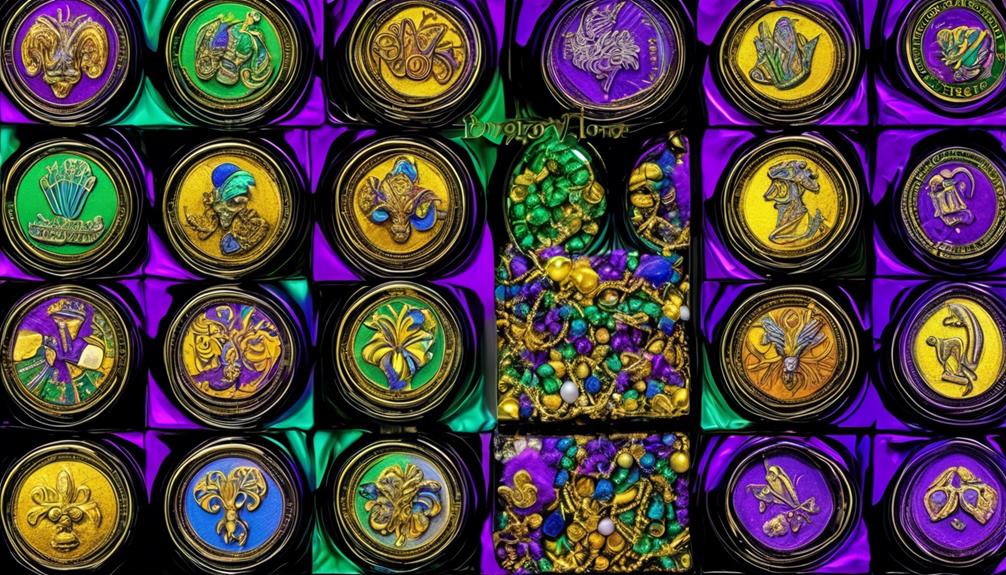
We've encountered some truly remarkable collections of Mardi Gras doubloons that offer valuable insights into the history and culture of this vibrant tradition.
From rare doubloon finds to the historical significance of specific pieces, these collections provide a fascinating glimpse into the evolution of these cherished tokens.
Additionally, the diverse and valuable varieties found within these collections offer a unique opportunity to explore the artistry and craftsmanship that goes into creating these iconic pieces.
Rare Doubloon Finds
In recent years, collectors and historians have uncovered several notable doubloon collections, shedding light on the rich history and significance of these rare Mardi Gras treasures. These valuable doubloon finds have often surfaced in rare doubloon auctions, drawing attention to their scarcity and historical importance. One such remarkable collection is the "Rex Doubloon Collection," which features a wide array of doubloons dating back to the early 20th century, offering a fascinating glimpse into the evolution of Mardi Gras celebrations. Additionally, the "Krewe of Orpheus Doubloon Set" stands out for its exquisite craftsmanship and limited availability, making it a highly sought-after addition to any doubloon enthusiast's collection. These rare doubloon finds not only hold substantial monetary value but also serve as tangible links to the storied traditions and cultural heritage of Mardi Gras.
| Notable Doubloon Collections | Description |
|---|---|
| Rex Doubloon Collection | Wide array of doubloons dating back to the early 20th century |
| Krewe of Orpheus Doubloon Set | Exquisite craftsmanship and limited availability |
Historical Significance
Exploring the historical significance of notable doubloon collections provides valuable insights into the evolution of Mardi Gras traditions and the cultural significance of these rare treasures.
Notable doubloon collections, such as the Alvin Sharpe Collection and the Rex Organization's doubloons, offer a glimpse into the rich history and cultural heritage of Mardi Gras.
The Alvin Sharpe Collection, for instance, showcases doubloons dating back to the 1960s, reflecting the intricate designs and themes of each year's celebration.
These collections serve as a testament to the enduring tradition of Mardi Gras and its evolution over time, capturing the spirit and creativity of each era.
Furthermore, they provide a unique lens through which to understand the cultural significance of Mardi Gras doubloons, highlighting their role as cherished mementos that connect generations to the vibrant history of this celebrated tradition.
Valuable Varieties
The historical significance of notable doubloon collections, such as the Alvin Sharpe Collection and the Rex Organization's doubloons, offers a valuable lens through which to appreciate the diverse and valuable varieties of Mardi Gras doubloons.
These collections showcase rare varieties and unique designs that have become highly sought after by collectors and enthusiasts. The Alvin Sharpe Collection, for instance, is renowned for its rare and exceptional doubloons, including limited edition pieces that hold significant historical and cultural value.
Similarly, the Rex Organization's doubloons are celebrated for their unique designs, often featuring intricate artwork and symbols that reflect the rich traditions of Mardi Gras.
Exploring these notable collections provides a fascinating insight into the evolution and diversity of Mardi Gras doubloons, highlighting the allure and value of these unique treasures.
Doubloon Grading Standards

Grading standards for Mardi Gras doubloons reflect the quality and condition of these collectible coins, influencing their value among enthusiasts and collectors. Understanding the grading criteria and market trends is crucial for assessing the worth of these elusive treasures.
Here are three key factors that determine the grading standards for Mardi Gras doubloons:
- Condition: The condition of a doubloon is a primary factor in determining its grade. Factors such as wear and tear, scratches, and overall preservation play a significant role in assessing the coin's condition.
- Design and Detail: The intricacy and sharpness of the design on the doubloon also impact its grade. Well-defined details and minimal design flaws contribute to a higher grade.
- Rarity: The rarity of a specific doubloon design or year of release can greatly influence its grade and value. Rare and unique doubloons often command higher grades and prices in the market.
Understanding these grading standards and staying updated on current market trends is essential for collectors and enthusiasts looking to assess the value of their Mardi Gras doubloons accurately.
Vintage Doubloon Market Trends
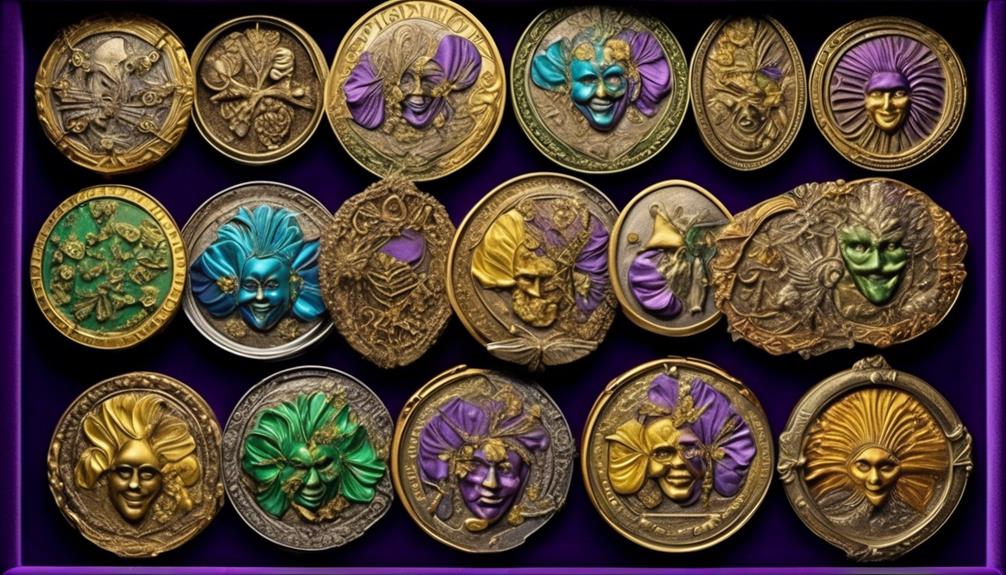
Analyzing vintage doubloon market trends reveals valuable insights into the evolving demand and value of these collectible coins. When examining vintage doubloon pricing and antique doubloon market trends, it becomes evident that the market is influenced by various factors such as historical significance, rarity, and condition of the doubloons. Below is a table presenting recent vintage doubloon market trends, showcasing the average prices of select vintage doubloons over the past five years.
| Doubloon Type | Average Price (5 Years Ago) | Current Average Price | Price Increase |
|---|---|---|---|
| Krewe of Rex 1960 | $15 | $50 | 233.33% |
| Comus 1955 | $20 | $75 | 275% |
| Proteus 1970 | $10 | $40 | 300% |
| Momus 1965 | $25 | $90 | 260% |
As seen in the table, the average prices of vintage doubloons have significantly increased over the past five years, highlighting a growing interest in these antique coins. This trend suggests that vintage doubloons continue to be a lucrative investment option, with their value appreciating substantially over time.
Modern Doubloon Enthusiasm
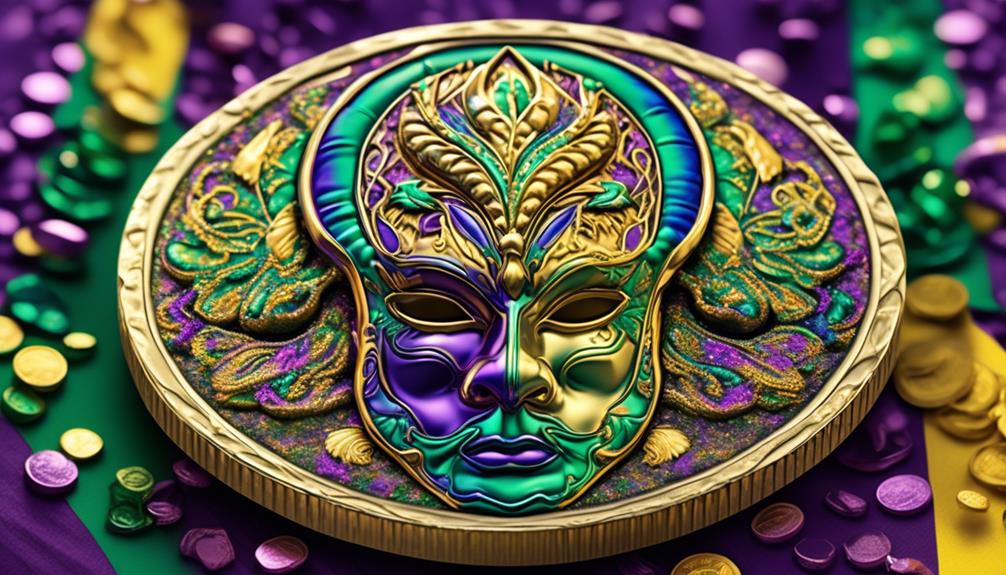
Examining the burgeoning interest in vintage doubloons provides valuable insights into the current enthusiasm for modern iterations of these collectible coins. In the digital age, collecting modern doubloons has gained significant traction, driven by a combination of factors such as nostalgia, community, and innovation.
- Nostalgia: Modern doubloon enthusiasts often have fond memories of receiving these colorful coins during Mardi Gras celebrations. The desire to recreate or continue these traditions fuels their passion for collecting modern doubloons.
- Community: The digital age has facilitated the creation of online communities centered around modern doubloon collecting. Enthusiasts can now connect with like-minded individuals, share their collections, and participate in trading, fostering a sense of camaraderie and belonging.
- Innovation: Modern doubloon designs often incorporate cutting-edge techniques and technology, appealing to collectors who appreciate innovation and creativity. The use of digital art, intricate details, and limited editions adds a layer of exclusivity and excitement to the modern doubloon market.
Preservation and Display Tips

Preserving and displaying modern doubloons requires careful consideration of environmental factors and storage methods to ensure their long-term condition and visual appeal. When it comes to preservation tips, it is essential to protect doubloons from exposure to air, moisture, and direct sunlight, as these elements can cause tarnishing or discoloration. Display ideas should also take into account the need to showcase doubloons while safeguarding them from potential damage.
Here are some preservation and display tips to help maintain the quality and appeal of modern doubloons:
| Preservation Tips | Display Ideas |
|---|---|
| Store doubloons in airtight containers or protective sleeves to prevent oxidation and tarnishing | Create a shadow box display to exhibit doubloons while keeping them safe from physical contact |
| Use desiccant packets in storage containers to absorb any moisture and maintain the condition of the doubloons | Consider using specialized coin holders or capsules to showcase individual doubloons, allowing for easy viewing without direct handling |
| Avoid cleaning doubloons with abrasive materials or harsh chemicals, as this can lead to damage | Utilize LED lighting to illuminate and highlight displayed doubloons without emitting harmful UV rays |
| Keep doubloons in a stable environment with controlled temperature and humidity levels to prevent deterioration | Arrange doubloons in a way that tells a story or highlights their historical or thematic significance |
Identifying Valuable Doubloons

Upon close examination of modern doubloons, it becomes evident that certain key characteristics and markings play a significant role in determining their value and rarity. Identifying markings and understanding the authentication process are crucial in determining the worth of Mardi Gras doubloons. Here are three key aspects to consider when identifying valuable doubloons:
- Year and Origin: The year of release and the krewe or organization that issued the doubloon can significantly impact its value. Older doubloons from prestigious krewes are often more valuable due to their rarity and historical significance.
- Metal Content and Weight: Authentic doubloons are typically made from metal, such as aluminum, bronze, or silver. Understanding the metal content and weight of a doubloon is essential for determining its authenticity and potential worth.
- Uniqueness and Condition: Special edition or rare doubloons, particularly those with unique designs or misprints, are highly sought after by collectors. Additionally, the condition of the doubloon, including any signs of wear or damage, can influence its value.
Careful examination of these factors, along with the assistance of experts in numismatics, can aid in accurately identifying and assessing the value of Mardi Gras doubloons.
Doubloon Appraisal Process

We will conduct a comprehensive assessment of the doubloon appraisal process to provide a detailed understanding of the methods used to determine the value of Mardi Gras doubloons.
The doubloon authentication process is a critical component of determining the market value of these unique collectibles. Appraisers use a combination of factors to authenticate doubloons, including their size, weight, design intricacy, and historical significance. They also consider the rarity of the doubloon, which can be influenced by factors such as limited production runs, special editions, or unique designs commemorating significant events or anniversaries.
Market value fluctuations are another crucial aspect of the doubloon appraisal process. Fluctuations can occur due to changes in demand, shifts in popular designs or themes, and the overall condition of the doubloons. Additionally, market trends and the buying behavior of collectors can impact the value of Mardi Gras doubloons. Appraisers stay informed about these fluctuations to provide accurate and up-to-date assessments.
Understanding the doubloon appraisal process is essential for collectors and enthusiasts who want to accurately assess the value of their Mardi Gras doubloons.
Monetizing Doubloons
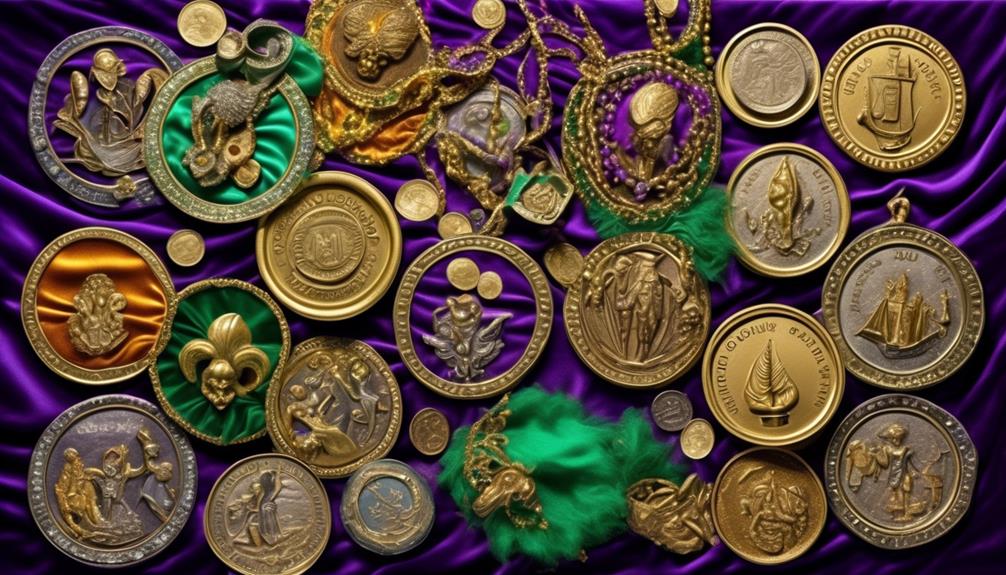
When it comes to monetizing Mardi Gras doubloons, it's essential to consider their value, the demand in the collectible market, and their historical significance.
Understanding the value of doubloons involves evaluating their rarity, condition, and the current market trends.
Additionally, the demand for these doubloons in the collectible market can significantly influence their monetization potential.
Furthermore, their historical significance can add a layer of cultural and historical value to these unique items.
Value of Doubloons
The value of Mardi Gras doubloons can vary significantly depending on factors such as rarity, historical significance, and current market demand. Understanding the worth of these treasured items involves an authentication process and staying attuned to market trends.
Here's what to consider:
- Rarity: Doubloons from specific krewes or years may be rarer and thus more valuable.
- Historical Significance: Doubloons with connections to significant events or themes may fetch higher prices.
- Current Market Demand: Trends in collecting and the overall market for Mardi Gras doubloons can influence their value.
Collectible Market Demand
Monetizing Mardi Gras doubloons involves assessing their appeal to collectors and understanding the factors that drive their value in the current market. The demand for these collectibles is influenced by market trends and the growing popularity of digital collecting. Understanding these dynamics can help collectors and sellers navigate the market effectively.
| Factors Driving Market Value | Appeal to Collectors | Digital Collecting |
|---|---|---|
| Historical significance | Rarity and uniqueness | Online trading platforms |
| Condition of the doubloon | Artistic design | Digital display and sharing |
| Commemorative themes | Connection to specific events | Virtual collecting communities |
As market trends evolve, the demand for Mardi Gras doubloons may shift, impacting their value. Embracing digital collecting trends can open up new avenues for buying, selling, and enjoying these fascinating pieces of history.
Historical Significance
Exploring the historical significance of Mardi Gras doubloons allows for a deeper understanding of their monetary value within the collectible market and sheds light on the factors that contribute to their desirability among collectors.
- Cultural Significance: Doubloons originated as aluminum coins minted for Mardi Gras parades in the 1960s, reflecting the rich cultural tradition of New Orleans and the carnival season.
- Historical Context: Understanding the historical context of doubloons, including their evolution from simple aluminum tokens to intricately designed collectibles, adds depth to their appeal.
- Connection to Tradition: The historical significance of doubloons ties them to the vibrant history and traditions of Mardi Gras, making them not just collectible items, but artifacts that encapsulate the spirit of the festival.
Appreciating the historical and cultural significance of Mardi Gras doubloons adds a layer of value beyond their material worth, making them cherished pieces of history for collectors.
Investing in Doubloons

How can investing in Mardi Gras doubloons provide a unique opportunity for diversifying a portfolio and potentially yielding lucrative returns?
When considering an investment strategy, it's crucial to examine market trends and historical performance. Mardi Gras doubloons have shown a consistent increase in value over the years, making them an intriguing option for investors seeking to diversify their portfolios.
Market trends indicate that the demand for Mardi Gras doubloons has been steadily rising, especially among collectors and enthusiasts. This sustained interest suggests that investing in these unique coins could offer a promising opportunity for capital appreciation. Additionally, the limited supply of vintage doubloons further contributes to their appeal as a collectible investment.
Furthermore, the historical significance and cultural relevance of Mardi Gras doubloons add an extra layer of value to these coins, potentially making them more resilient to market fluctuations compared to traditional investment assets.
Incorporating Mardi Gras doubloons into an investment portfolio can provide an alternative avenue for generating returns while also adding diversity. However, as with any investment, thorough research and consideration of individual financial goals are essential before making investment decisions.
Doubloon Value Fluctuations
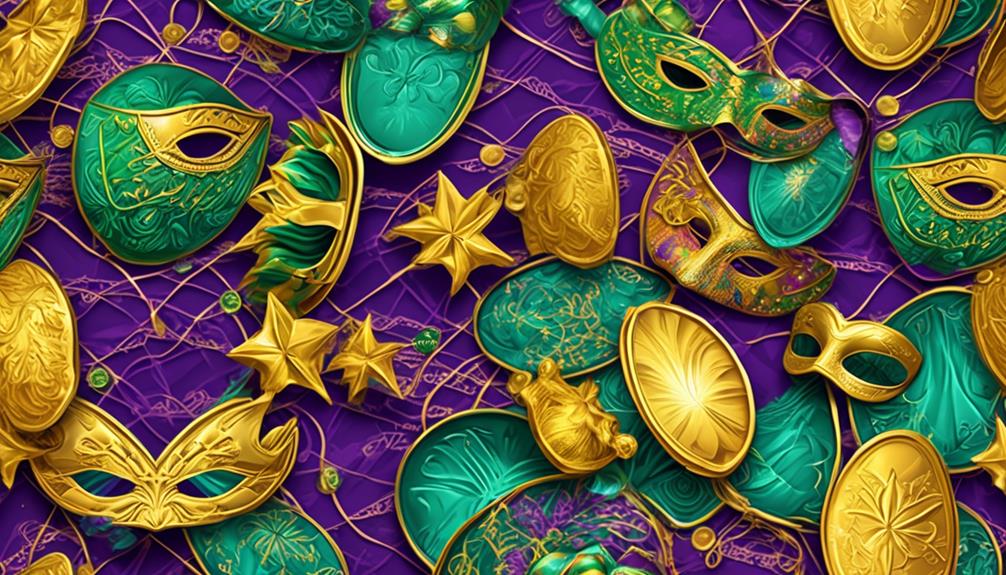
The sustained interest in Mardi Gras doubloons as a collectible investment has prompted a closer examination of their value fluctuations over time. Understanding the economic impact and market trends, as well as the cultural significance and symbolism of these coins, is essential for evaluating their worth as an investment.
Here are three key factors that contribute to the fluctuations in doubloon value:
- Economic Impact: The value of Mardi Gras doubloons can be influenced by broader economic conditions, such as inflation, interest rates, and the overall state of the economy. During periods of economic uncertainty, the demand for alternative investments like collectibles may increase, affecting the market value of doubloons.
- Market Trends: Like any collectible, the value of Mardi Gras doubloons is subject to market trends. The popularity of Mardi Gras celebrations, as well as shifts in the preferences of collectors, can impact the demand for specific doubloons, leading to fluctuations in their value.
- Cultural Significance and Symbolism: Doubloons often hold cultural significance and symbolism, reflecting the traditions and history of Mardi Gras. Shifts in societal attitudes towards these cultural elements can affect the perceived value of doubloons among collectors.
Considering these factors can provide valuable insights into the potential fluctuations in the value of Mardi Gras doubloons.
Future of Doubloon Collecting
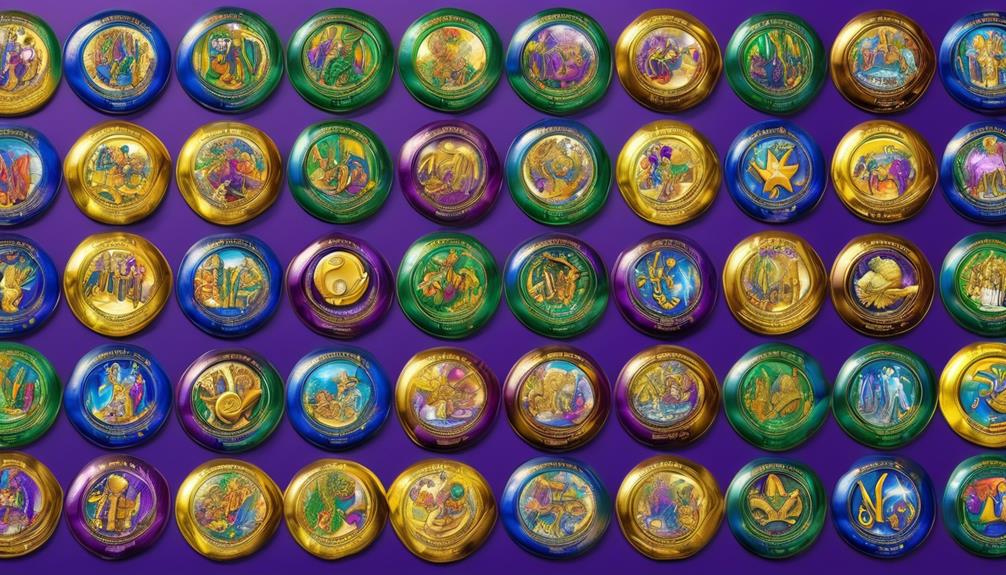
As collectors of Mardi Gras doubloons, we must consider the impact of the digital age on the future of our hobby.
The increasing rarity and demand for these unique treasures will undoubtedly shape the way we approach collecting in the years to come.
Additionally, the potential for doubloons to become valuable investments adds another layer of complexity to the future landscape of doubloon collecting.
Value in Digital Age
In the digital age, the future of doubloon collecting is undergoing a significant transformation as technology and online platforms are reshaping the value and accessibility of these prized collectibles.
- Digital Currency: With the rise of digital currency and blockchain technology, the concept of digital doubloons is becoming a reality, adding a new dimension to the collectible market.
- Online Marketplaces: Online platforms have revolutionized the buying and selling of doubloons, providing collectors with a global marketplace and access to a wider range of items than ever before.
- Authentication and Verification: Advanced technologies such as blockchain and digital signatures are being utilized to authenticate and verify the provenance of doubloons, enhancing trust and transparency within the collecting community.
These developments point to an exciting future for doubloon collecting in the digital age, offering new opportunities for enthusiasts to engage with and invest in these historic treasures.
Rarity and Demand
Analyzing the historical trends and current market indicators, the future of doubloon collecting appears to be shaped by the interplay of rarity and escalating demand among collectors and investors alike.
Rarity trends play a crucial role in determining the value of doubloons. As collectors seek to complete their sets or acquire unique pieces, the scarcity of certain doubloons drives up their desirability and market value.
However, market demand fluctuations also significantly impact the future of doubloon collecting. The ebb and flow of interest in Mardi Gras doubloons can influence their perceived value, creating opportunities for both seasoned collectors and new enthusiasts.
Understanding these dynamics is essential for predicting the trajectory of doubloon collecting in the future, as it's the delicate balance between rarity and demand that will continue to shape this niche market.
Collecting for Investment
With an eye toward long-term potential, investing in doubloons can offer a strategic avenue for diversifying a collector's portfolio and capitalizing on the historical significance of these coveted artifacts.
Here's why doubloon collecting holds promise for investment:
- Investment Potential: Doubloons, especially those with unique designs or from significant historical events, have shown a consistent increase in value over time, making them an attractive investment option.
- Market Trends: The market for rare and historically significant doubloons continues to grow, indicating strong potential for long-term value appreciation.
- Financial Benefits: As an alternative investment, doubloons can provide diversification and a hedge against market volatility, potentially offering stable returns over the long term.
Frequently Asked Questions
Where Can I Buy Mardi Gras Doubloons Online?
We've found that online marketplaces like eBay and Etsy offer a wide variety of doubloon designs for purchase. You can explore unique and vintage options from different sellers. These platforms often provide detailed descriptions and images to help you make informed decisions.
Keep in mind to check seller ratings and reviews for a smooth buying experience.
Happy hunting for the perfect Mardi Gras doubloons to add to your collection!
Are There Any Special Events or Festivals Where I Can Trade or Purchase Doubloons in Person?
Looking to join the excitement of Mardi Gras parades and indulge in Doubloon trading?
There are various events and festivals where you can engage in the thrill of exchanging these prized collectibles.
Mardi Gras parade routes often host Doubloon swap meets, and festival vendors offer opportunities for trading or purchasing doubloons in person.
It's a fantastic way to immerse yourself in the vibrant culture and tradition of Mardi Gras while expanding your collection.
Can I Use Doubloons as Currency in New Orleans During Mardi Gras?
Yes, during Mardi Gras, using doubloons as currency is a popular tradition in New Orleans.
Mardi Gras doubloons hold sentimental value and are often used as payment for goods and services during the festival.
The exchange rate for doubloons can vary depending on the collector's market and the rarity of the doubloon.
Many vendors and businesses in the city accept doubloons as a form of payment, adding to the festive atmosphere.
Are There Any Famous Individuals or Celebrities Known for Their Doubloon Collections?
Famous collectors of Mardi Gras doubloons include actor Nicolas Cage, known for his extensive collection, and renowned musician Fats Domino. These celebrity endorsements have increased the allure of doubloons, making them highly sought after by both collectors and enthusiasts.
The unique designs and historical significance of these doubloons add to their appeal, making them valuable not only as collectibles but also as pieces of cultural heritage.
Is There a Specific Organization or Group for Doubloon Enthusiasts to Join?
Doubloon collectors often seek out online communities and doubloon conventions to connect with fellow enthusiasts. These groups provide a platform for sharing information, trading, and discussing the valuation of rare doubloons.
One notable organization is the International Association of Mardi Gras Doubloon Collectors, which hosts annual conventions and offers resources for enthusiasts.
Engaging with such groups can offer valuable insights and opportunities for connecting with like-minded individuals passionate about Mardi Gras doubloons.
Conclusion
In conclusion, the value of Mardi Gras doubloons is a complex and ever-evolving topic. With a rich history, intricate designs, and various factors affecting their worth, doubloons hold a unique place in the world of collectibles.
As we continue to uncover rare discoveries and witness fluctuations in value, the future of doubloon collecting is full of excitement and potential. Stay tuned for more updates on this fascinating and dynamic market.
- About the Author
- Latest Posts
Introducing Ron, the home decor aficionado at ByRetreat, whose passion for creating beautiful and inviting spaces is at the heart of his work. With his deep knowledge of home decor and his innate sense of style, Ron brings a wealth of expertise and a keen eye for detail to the ByRetreat team.
Ron’s love for home decor goes beyond aesthetics; he understands that our surroundings play a significant role in our overall well-being and productivity. With this in mind, Ron is dedicated to transforming remote workspaces into havens of comfort, functionality, and beauty.
Mardi Gras Decoration
What Is a Popular New Orleans Drink?
In New Orleans, the city’s famous beverages flow freely just like the Mississippi River on a hot summer day. The vibrant culture and deep history of this city have inspired some of the most distinctive and cherished cocktails in the world.
From the famous Hurricane to the mysterious Vieux Carré, there's a drink for every palate in the Big Easy. But what exactly makes these drinks so special, and where can one find the best places to experience them?
Stay tuned as we uncover the secrets behind the popular New Orleans libations and where to savor them in their true element.
Key Takeaways
- The Sazerac, Hurricane, Ramos Gin Fizz, and Vieux Carré are some of the most popular drinks in New Orleans.
- These drinks are made with signature ingredients such as rye whiskey, absinthe, rum, fruit juice, and various liqueurs.
- Notable bars and restaurants in New Orleans, such as Pat O'Brien's, Lafitte's Blacksmith Shop, and the Carousel Bar & Lounge, are known for serving these iconic cocktails.
- New Orleans' cocktails have cultural and historical significance, representing the city's diverse influences and contributing to its vibrant food and cocktail scene.
The History of New Orleans Cocktails
The history of New Orleans cocktails dates back to the early 19th century, intertwining with the city's rich cultural tapestry and culinary heritage. One of the most iconic cocktails to emerge from this vibrant concoction of influences is the Sazerac. Its evolution showcases the innovative spirit that characterizes New Orleans' cocktail culture.
The Sazerac, believed to be one of the world's oldest cocktails, originated in the 1830s, making it a true testament to the city's pioneering role in cocktail innovation.
The Sazerac's evolution reflects the dynamic nature of New Orleans' cocktail scene. From its humble beginnings as a medicinal concoction to its current status as a revered classic, the Sazerac has undergone several transformations while remaining deeply rooted in the city's history. This cocktail's journey mirrors the broader narrative of cocktail innovation in New Orleans, where creativity and tradition intersect to produce timeless libations.
The intricate tale of New Orleans cocktails is a testament to the city's enduring legacy as a cradle of mixology, where each sip offers a glimpse into the rich tapestry of its spirited past.
The Iconic Hurricane
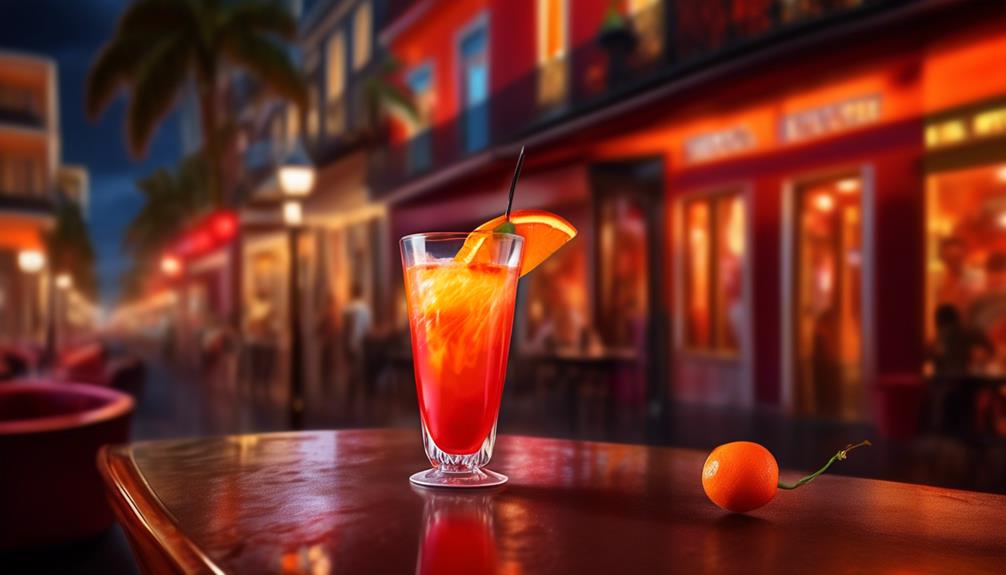
One of the most iconic cocktails to emerge from the rich cocktail culture of New Orleans is the Hurricane, a drink that holds a significant place in the city's spirited legacy. The Hurricane cocktail originated at Pat O'Brien's bar in the 1940s and has since become a symbol of the vibrant and indulgent essence of New Orleans. This delectable concoction is typically made with rum, fruit juice, and syrup, delivering a sweet yet potent punch that has made it a favorite among locals and visitors alike.
To provide a glimpse into the diverse world of Hurricane variations and the popular bars where this iconic drink can be enjoyed, take a look at the table below:
| Popular Hurricane Bars | Hurricane Variations |
|---|---|
| Pat O'Brien's (French Quarter) | Classic Hurricane |
| Lafitte's Blacksmith Shop (French Quarter) | Passion Fruit Hurricane |
| The Carousel Bar & Lounge at Hotel Monteleone | Mango Hurricane |
| Beachbum Berry's Latitude 29 | Pineapple Hurricane |
| Tiki Tolteca | Strawberry Hurricane |
These bars offer an authentic New Orleans experience and showcase the unique variations of the Hurricane, allowing patrons to savor the rich history and delightful flavors of this iconic cocktail.
Exploring the Classic Sazerac
Let's journey back to the 19th century, when the Sazerac first made its mark in the historic city of New Orleans. Originating as a medicinal elixir, this iconic cocktail has stood the test of time, evolving into a beloved classic.
With its unique blend of rye whiskey, absinthe, bitters, and a touch of sugar, the Sazerac continues to be a staple in the Big Easy's vibrant cocktail culture.
Sazerac History
In the heart of New Orleans, a timeless cocktail with a rich history and enduring legacy is the Sazerac.
The origins of the Sazerac date back to the 19th century, where it was crafted with Sazerac brandy, absinthe, Peychaud's Bitters, and a sugar cube. Over time, variations of the Sazerac emerged, with some using rye whiskey as the base instead of brandy, while others incorporate different types of bitters or even substitute absinthe with other anise-flavored liqueurs.
The Sazerac has become a symbol of New Orleans' cocktail culture, embodying the city's unique blend of French, American, and Creole influences. Its enduring popularity is a testament to its exquisite balance and deep roots in the city's vibrant history.
Sazerac Recipe
The classic Sazerac recipe traces its origins to the 19th century, featuring a harmonious blend of Sazerac brandy or rye whiskey, absinthe, Peychaud's Bitters, and a sugar cube.
When crafting this iconic cocktail, mixology techniques play a pivotal role. The key lies in the careful muddling of the sugar cube with Peychaud's Bitters, followed by the addition of the Sazerac brandy or rye whiskey. This process ensures a balanced infusion of flavors, creating a rich and aromatic base.
The use of absinthe to coat the serving glass adds an alluring depth to the drink's flavor profile, enhancing its complexity.
In New Orleans, where cocktail culture thrives, serving traditions dictate that the Sazerac is traditionally presented in an Old Fashioned glass, emphasizing the drink's historical significance and timeless appeal.
The Refreshing Ramos Gin Fizz
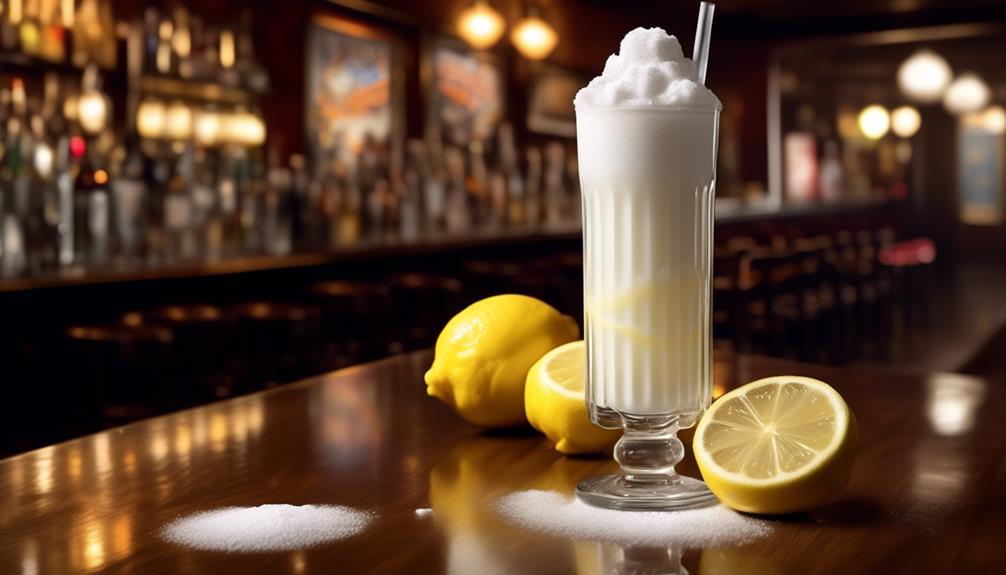
Let's talk about the refreshing Ramos Gin Fizz.
This classic cocktail has a fascinating history and origin, dating back to the late 1800s in New Orleans.
Its signature ingredients, including gin, lemon juice, sugar, cream, and orange flower water, create a delightful and frothy concoction that has stood the test of time.
Classic Cocktail Recipe
For aficionados of classic cocktails, one libation that stands the test of time and continues to captivate the discerning palate is the refreshing Ramos Gin Fizz. This iconic cocktail has a rich history, dating back to the late 1800s in New Orleans.
The recipe for a perfect Ramos Gin Fizz involves a meticulous blend of ingredients and precise mixology techniques. Here's how to create this timeless delight:
- Combine 2 oz gin, 1/2 oz fresh lemon juice, 1/2 oz fresh lime juice, 1 oz simple syrup, 3 drops of orange flower water, 1 egg white, and 2 oz heavy cream in a shaker without ice.
- Shake vigorously for at least a minute to emulsify the ingredients.
- Add ice to the shaker and shake again until well chilled.
This classic cocktail, with its frothy texture and citrusy sweetness, is a true masterpiece of mixology.
History and Origin
Originating in the vibrant city of New Orleans in the late 1800s, the refreshing Ramos Gin Fizz has a rich and storied history that has captivated cocktail enthusiasts for generations.
Its origin and evolution are deeply rooted in the cultural significance of the city's renowned cocktail scene. Created by Henry C. Ramos, the drink gained immense popularity at the Imperial Cabinet Saloon, where it became an iconic representation of New Orleans' mixology.
The evolution of the Ramos Gin Fizz reflects the city's dynamic cultural melting pot, blending influences from French, Spanish, African, and American traditions.
This delightful concoction has stood the test of time, maintaining its allure through the decades. Its history is a testament to the enduring legacy of New Orleans' cocktail culture and its profound impact on the art of mixology.
Signature Ingredients
What are the key ingredients that give the Refreshing Ramos Gin Fizz its distinctive and timeless flavor?
The signature flavors of this iconic New Orleans drink are a carefully selected combination of ingredients that have stood the test of time. The popular variations of the Ramos Gin Fizz may have slight tweaks, but the classic recipe remains unchanged.
Here are the essential components that contribute to its unique taste:
- Gin: A smooth and aromatic base spirit that forms the backbone of the cocktail.
- Fresh lemon juice: Adds a tangy and citrusy kick, balancing the sweetness of the other ingredients.
- Cream and egg white: These ingredients create the frothy, velvety texture that sets the Ramos Gin Fizz apart from other cocktails.
These elements harmonize to produce a refreshing and indulgent beverage that has delighted drinkers for generations.
The Mysterious Vieux Carré
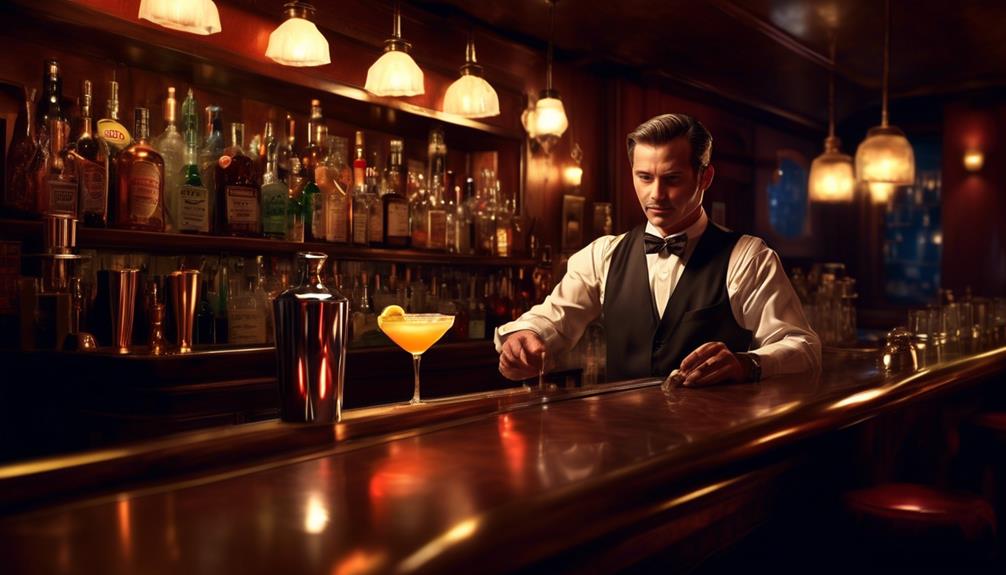
Steeped in the rich history of New Orleans, the Vieux Carré cocktail embodies the spirit of the city's vibrant culture and heritage. This iconic drink has deep roots in the cocktail culture of New Orleans and is a cherished tradition in the city's mixology scene. Created in the 1930s at the famed Carousel Bar, the Vieux Carré has stood the test of time, maintaining its popularity amidst evolving mixology trends.
The Vieux Carré is a complex and intriguing concoction, reflecting the diverse influences that have shaped New Orleans. Its blend of rye whiskey, cognac, and sweet vermouth, along with dashes of herbal liqueur and aromatic bitters, creates a symphony of flavors that dance on the palate. This timeless libation pays homage to the French and Creole heritage of the city, capturing the essence of its historic French Quarter, also known as the Vieux Carré.
Today, the Vieux Carré remains an integral part of New Orleans' drinking culture, celebrated by locals and visitors alike. Its enigmatic allure and timeless appeal continue to make it a revered symbol of the city's rich cocktail tradition.
Unraveling the Mystique of Absinthe Frappé
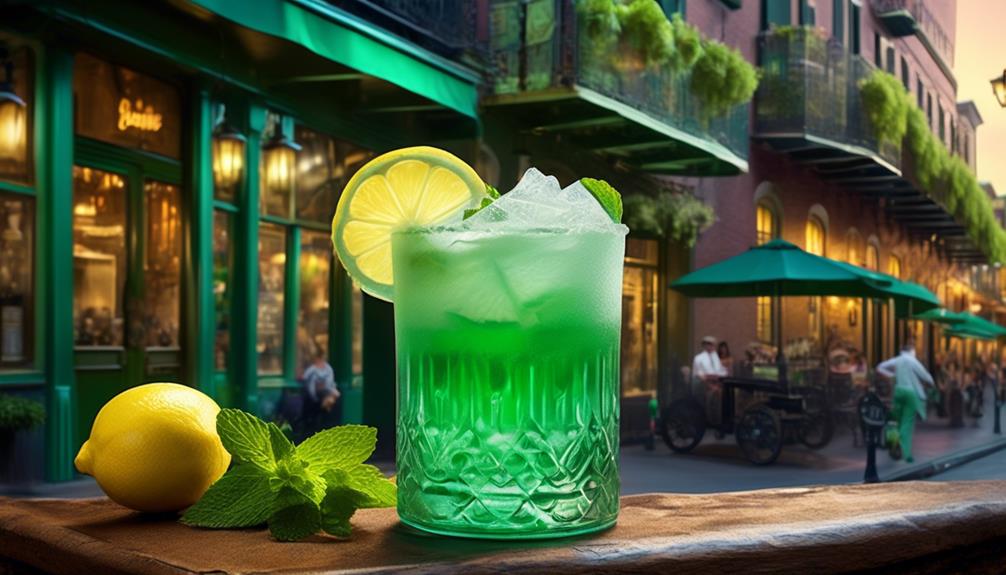
Unveiling the allure and historical significance of Absinthe Frappé reveals a fascinating journey through the annals of cocktail culture in New Orleans. Absinthe, with its storied past and deep ties to the city, has long been a key player in the vibrant tapestry of New Orleans' libations. When it comes to the enigmatic world of absinthe culture, the Absinthe Frappé stands out as a timeless classic, capturing the essence of the Green Fairy in a refreshing and invigorating drink.
Here are a few insights into the world of Absinthe Frappé:
- Origins: The Absinthe Frappé is believed to have originated in the late 19th century, gaining popularity in the iconic bars of New Orleans. Its creation is often attributed to Cayetano Ferrer, a renowned mixologist at the time.
- Preparation: The preparation of Absinthe Frappé involves the careful blending of absinthe, sugar, and fresh mint, all shaken with crushed ice to achieve a frosty, minty delight.
- Frappé Variations: Over the years, mixologists have put their own spin on the classic Absinthe Frappé, introducing variations that incorporate different herbs, fruits, and even flavored syrups, adding new dimensions to this beloved concoction.
The Absinthe Frappé continues to evoke the enchanting spirit of New Orleans' cocktail culture, inviting aficionados to savor its timeless allure and explore its diverse frappé variations.
The Unique Flavors of Pimm's Cup
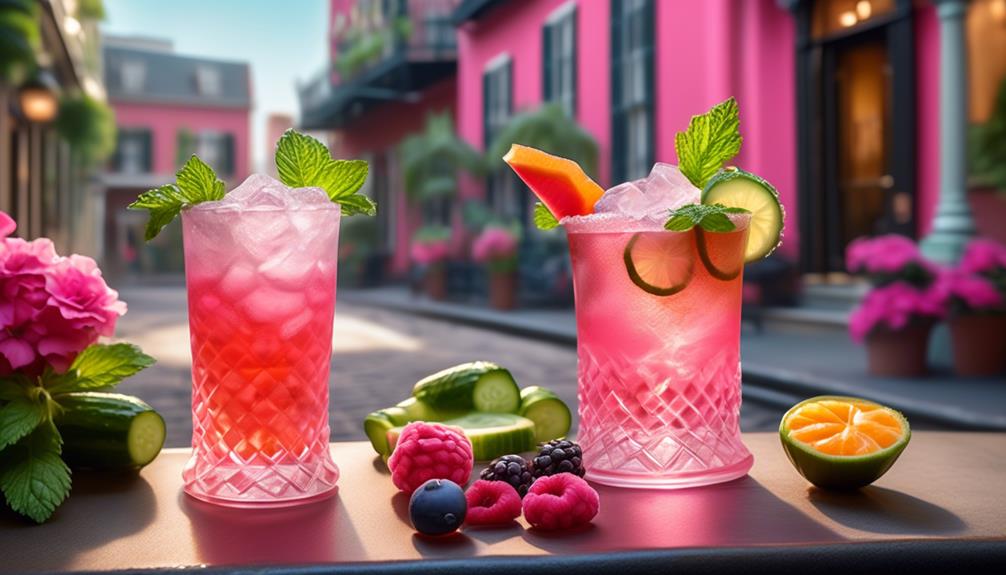
The Absinthe Frappé, an iconic fixture of New Orleans' cocktail culture, paves the way for our exploration of the distinct and refreshing flavors of Pimm's Cup. Pimm's Cup, a beloved beverage in the city, has evolved over time, leading to a plethora of variations that showcase the creativity of modern mixology techniques.
The traditional Pimm's Cup features Pimm's No. 1, a gin-based liqueur, mixed with lemonade or ginger ale, and garnished with fruits and herbs. However, contemporary bartenders have introduced innovative twists to this classic concoction. Variations may include the addition of fresh muddled fruits, artisanal syrups, or even a hint of spice for a modern touch. These adaptations elevate the drink's complexity while preserving its refreshing nature.
In the heart of New Orleans, one can expect to find a diverse array of Pimm's Cup interpretations, each reflecting the individual flair of the establishments and mixologists. Whether it's served over crushed ice or with a playful garnish, the varying renditions of Pimm's Cup offer a delightful journey through the city's vibrant and ever-evolving cocktail scene.
The Sweet and Bitter French 75
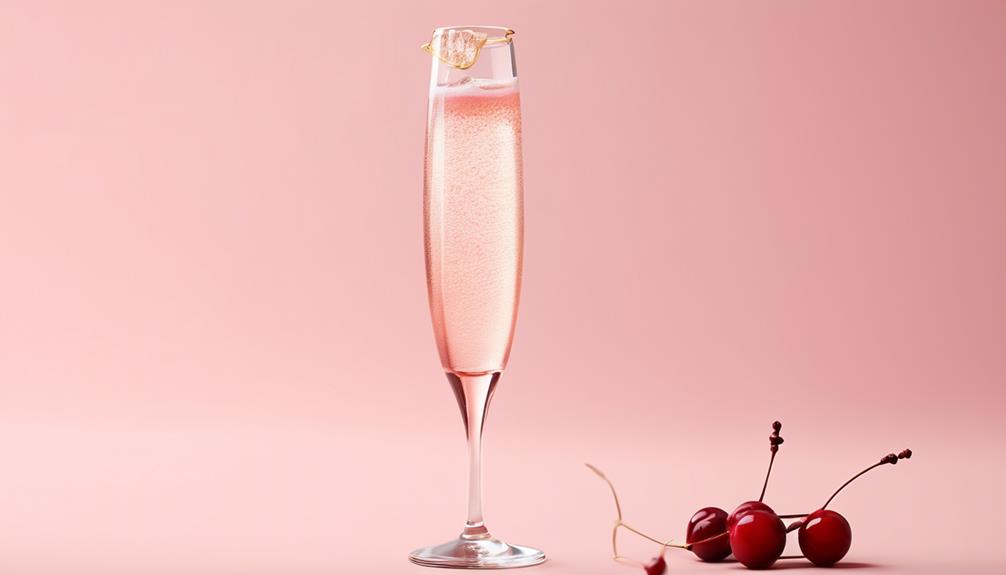
We adore the timeless allure of the French 75, a cocktail that seamlessly blends sweet and bitter notes. Its classic recipe dates back to the early 1900s, and it has remained a staple in New Orleans' vibrant cocktail scene.
The historical significance of this libation is undeniable, making it a must-try for anyone seeking a taste of the city's rich drinking culture.
Classic Cocktail Recipe
In the early 20th century, the Sweet and Bitter French 75 cocktail emerged as a timeless classic, blending gin, lemon juice, simple syrup, and Champagne to create a delightful and refreshing libation. This iconic cocktail has stood the test of time, delighting patrons with its perfect balance of sweet and tangy flavors.
The classic recipe for a French 75 includes:
- 2 ounces of gin
- 3/4 ounce of fresh lemon juice
- 1/2 ounce of simple syrup
- 2 ounces of Champagne
Cocktail variations abound, with some opting for cognac in place of gin or adding a splash of elderflower liqueur for a modern twist. Different serving styles also add to the allure of the French 75, whether it's served in a traditional champagne flute or a sleek coupe glass.
This beloved libation continues to captivate cocktail enthusiasts with its timeless appeal.
Historical Significance
Emerging from the cocktail renaissance of the early 20th century, the Sweet and Bitter French 75 has etched its place in history as an enduring and beloved libation, captivating patrons with its perfect blend of gin, lemon juice, simple syrup, and Champagne.
Its historical significance is profound, as it reflects the cultural impact of an era characterized by elegance, sophistication, and the zest for life. The Sweet and Bitter French 75 embodies the spirit of the Roaring Twenties, a time of celebration, innovation, and liberation. Its popularity soared during Prohibition, becoming a symbol of defiance and indulgence.
This iconic cocktail continues to enchant modern audiences, transporting them back to an era of glamour and revelry. Its historical significance and cultural impact endure, making it a timeless favorite among cocktail aficionados.
The Allure of the Brandy Milk Punch
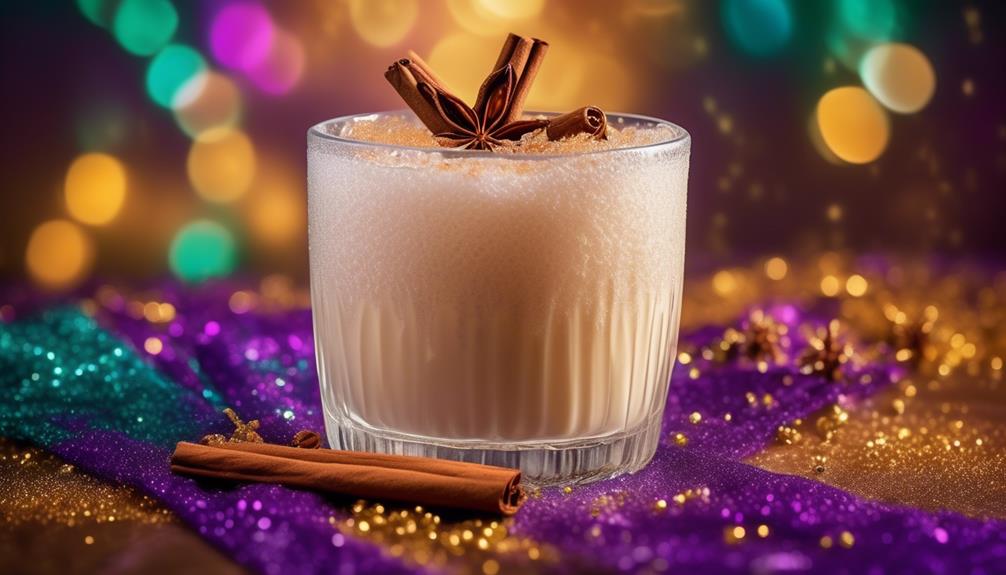
The allure of Brandy Milk Punch lies in its rich history and its timeless appeal as a classic New Orleans libation. This traditional recipe has been savored for centuries, evolving through the ages to adapt to modern variations while still retaining its essence. The popular bars of New Orleans have long been the guardians of this cherished concoction, each adding their own unique flavors to the mix, enriching the city's vibrant cocktail culture.
- Historical Significance: The Brandy Milk Punch has been a staple in New Orleans since the 19th century, enjoyed by both locals and visitors alike.
- Traditional Recipe: The original recipe consists of brandy, milk, powdered sugar, vanilla extract, and a sprinkle of nutmeg, creating a creamy and indulgent elixir.
- Modern Variations: While the traditional recipe remains beloved, modern mixologists have introduced innovative twists, incorporating ingredients like spiced syrups or flavored liqueurs to elevate the drink to new heights.
The Brandy Milk Punch encapsulates the spirit of New Orleans, blending history, tradition, and innovation into a single, delightful libation. Its allure isn't just in its taste, but in the stories and memories it carries, making it a cherished part of New Orleans' rich cultural tapestry.
The Signature Go-Cup Culture
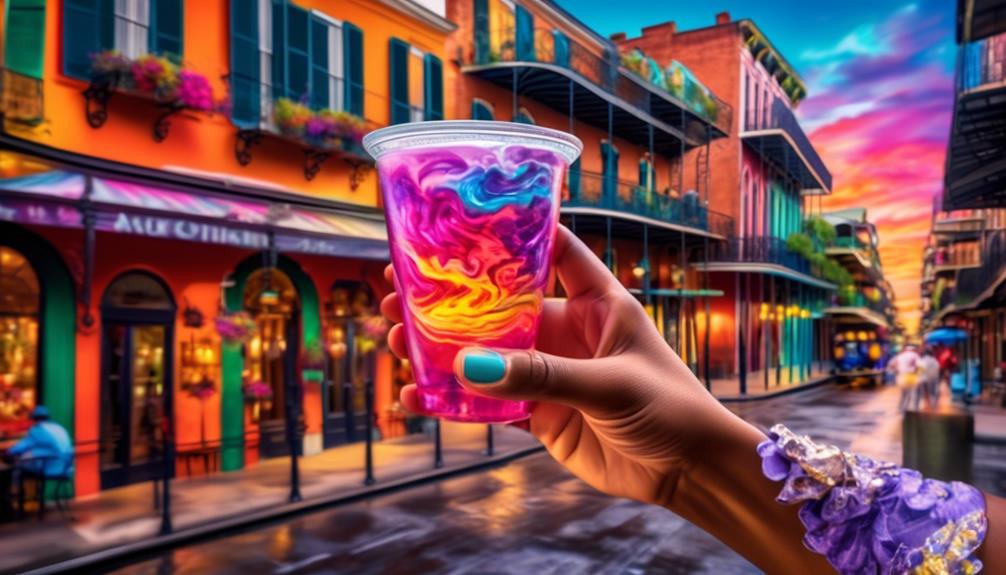
As we savor the allure of the Brandy Milk Punch, we find ourselves immersed in the vibrant culture of New Orleans, where the iconic go-cup has become a symbol of the city's laissez-faire attitude towards enjoying libations on the go.
The tradition of the go-cup dates back to the 1980s when the city legalized the consumption of alcoholic beverages on the streets within certain boundaries. This liberation led to the birth of a unique street drinking culture, where locals and visitors alike could stroll through the historic French Quarter with their favorite cocktails in hand.
The go-cup etiquette is a revered aspect of New Orleans' social fabric. It's customary to respect the community by not littering and to be mindful of others while indulging in the revelry of street-side imbibing.
As dusk settles over the city, the streets come alive with the sounds of jazz, laughter, and the clinking of plastic go-cups. This distinctive practice has become an essential part of the city's identity, allowing individuals to enjoy the rich tapestry of New Orleans' music, cuisine, and hospitality while embracing the freedom of the go-cup culture.
Discovering the Nostalgic Grasshopper

Indulging in the nostalgic Grasshopper cocktail, one experiences the rich heritage and flavors embedded in New Orleans' famous libations. The Grasshopper, with its creamy mint-chocolate goodness, has been a beloved fixture in the city's cocktail scene for decades, offering a taste of old-world charm and indulgence.
As we explore this iconic drink, we uncover the following:
- Historical Significance: The Grasshopper has a storied past, believed to have been created in the 1920s at a French Quarter bar. Its enduring popularity speaks to its deep roots in New Orleans' cocktail culture.
- Unique Flavors: The cocktail's harmonious blend of crème de menthe, white crème de cacao, and cream creates a decadent, dessert-like experience that sets it apart from other nostalgic cocktails.
- Cultural Influence: The Grasshopper's influence extends beyond its delectable taste, intertwining with the city's vibrant history and social life, making it a symbol of conviviality and celebration.
The Grasshopper embodies the essence of New Orleans, offering a glimpse into the city's rich past and the unique flavors that have delighted locals and visitors alike for generations.
The Influence of Hand Grenade

Amidst the bustling cocktail scene of New Orleans, the Grasshopper's influence is palpable, and it is in this spirited environment that the Hand Grenade made its mark as a formidable contender. The Hand Grenade's popularity soared due to its unique blend of flavors and distinctive, grenade-shaped container. This iconic drink has had a profound cultural impact, becoming synonymous with the vibrant spirit of Bourbon Street. Its neon green hue and catchy slogan "The Most Powerful Drink in New Orleans" became ingrained in the city's folklore. The marketing strategies for the Hand Grenade, including its exclusive availability at Tropical Isle, contributed to its allure. The drink's widespread popularity is evident in the countless souvenir shops proudly displaying Hand Grenade-themed merchandise.
| Cultural Impact | Hand Grenade Popularity | Marketing Strategies |
|---|---|---|
| Became iconic | Soared in popularity | Exclusive availability |
| Synonymous with Bourbon Street | Ingrained in city folklore | Catchy slogan |
| Emblematic of New Orleans vibrancy | Countless souvenir shops | Unique container design |
The Hand Grenade is a testament to the way a drink can become more than a beverage, transcending into a symbol of a city's lively and unapologetic spirit.
Where to Find New Orleans Drinks
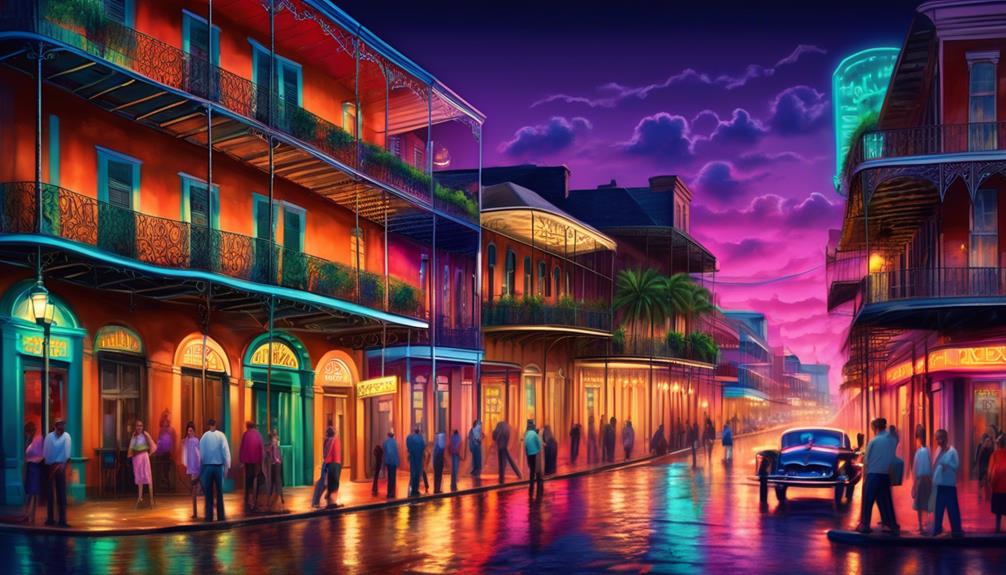
In our quest to discover the authentic New Orleans drinks, one can find an array of iconic beverages served in historic bars, renowned restaurants, and vibrant street-side establishments.
When seeking the best bars to sample local favorites, one must visit the historic Napoleon House, where the Pimm's Cup has been enjoyed for over a century.
Another must-visit is the elegant Carousel Bar at Hotel Monteleone, famous for its Vieux Carré cocktail and revolving carousel seating.
For a more laid-back experience, the beloved Pat O'Brien's courtyard is the perfect spot to savor their signature Hurricane cocktail while enjoying live music.
Lastly, no search for New Orleans drinks would be complete without a visit to Lafitte's Blacksmith Shop, the oldest bar in the country, known for its potent and mysterious Voodoo Daiquiri.
These establishments not only serve up the best drinks but also offer a glimpse into the rich history and culture of this vibrant city.
Frequently Asked Questions
What Are Some Non-Alcoholic Drinks Popular in New Orleans?
Some popular non-alcoholic drinks in New Orleans include refreshing mocktail options like the classic Mint Julep mocktail and the zesty Hurricane mocktail, which are inspired by the city's vibrant beverage culture.
New Orleans has a rich tradition of crafting flavorful non-alcoholic beverages to cater to all tastes, from sweet and fruity concoctions to tangy and herbal infusions.
These mocktails offer a delightful way to savor the city's unique beverage culture.
Are There Any Specific Drinking Traditions or Customs Associated With New Orleans Cocktails?
Drinking traditions in New Orleans have deep cultural significance, often tied to celebrations and community gatherings. The city's cocktails, like the Sazerac and Hurricane, are steeped in history and reflect the unique blend of influences that define New Orleans.
From toasting at Mardi Gras to sipping a cocktail at a jazz club, the act of imbibing is intertwined with the city's spirit. These customs continue to shape the vibrant social fabric of New Orleans.
What Are Some Lesser-Known or Underrated New Orleans Drinks That Visitors Should Try?
When it comes to signature cocktails in New Orleans, there are hidden gems that visitors should definitely try. These lesser-known drinks often hold a rich historical significance and offer a unique taste of the city's culture.
From the refreshing Ramos Gin Fizz to the complex Vieux Carré, there are plenty of underrated options waiting to be discovered.
Exploring these lesser-known drinks adds an authentic and intimate touch to the New Orleans experience.
Are There Any Local Ingredients or Unique Flavors That Are Commonly Used in New Orleans Cocktails?
Local ingredients and unique flavors are integral to New Orleans cocktails. Mixology techniques here reflect our city's rich history and diverse culture.
From the use of indigenous herbs and spices to the incorporation of tropical fruits, our cocktails capture the essence of the region.
Cocktail trends in New Orleans often celebrate the fusion of traditional and modern flavors, creating a truly unique drinking experience that pays homage to our vibrant culinary heritage.
Can You Recommend Any Specific Bars or Restaurants in New Orleans Known for Their Exceptional Cocktail Offerings?
We've discovered some remarkable speakeasy bars and hidden gems in New Orleans, where craft cocktail trends and mixology expertise shine.
These establishments, like *insert bar/restaurant name*, are known for their exceptional cocktail offerings. From classic concoctions to innovative creations, these places boast a rich history and an intimate ambiance, making them must-visit destinations for cocktail enthusiasts.
Get ready to embark on a journey through time and flavor at these unique spots.
Conclusion
As we sip on the iconic Hurricane, let's reflect on the intricate history of New Orleans cocktails.
Each drink tells a story of the city's rich cultural heritage, from the classic Sazerac to the refreshing Ramos Gin Fizz.
Just like the layers of flavors in a Vieux Carré, the drinks of New Orleans offer a complex and intriguing experience.
So, next time you visit, be sure to indulge in the city's signature go-cup culture and discover the nostalgic Grasshopper.
Cheers to the spirit of New Orleans!
- About the Author
- Latest Posts
Introducing Ron, the home decor aficionado at ByRetreat, whose passion for creating beautiful and inviting spaces is at the heart of his work. With his deep knowledge of home decor and his innate sense of style, Ron brings a wealth of expertise and a keen eye for detail to the ByRetreat team.
Ron’s love for home decor goes beyond aesthetics; he understands that our surroundings play a significant role in our overall well-being and productivity. With this in mind, Ron is dedicated to transforming remote workspaces into havens of comfort, functionality, and beauty.
Architecture Home Styles
Exploring Historic Roofing Materials Used in 1900: A How-To Guide
Mysteries of the past await in the intricate world of historic roofing materials from 1900 – uncover secrets and stories that will leave you captivated.
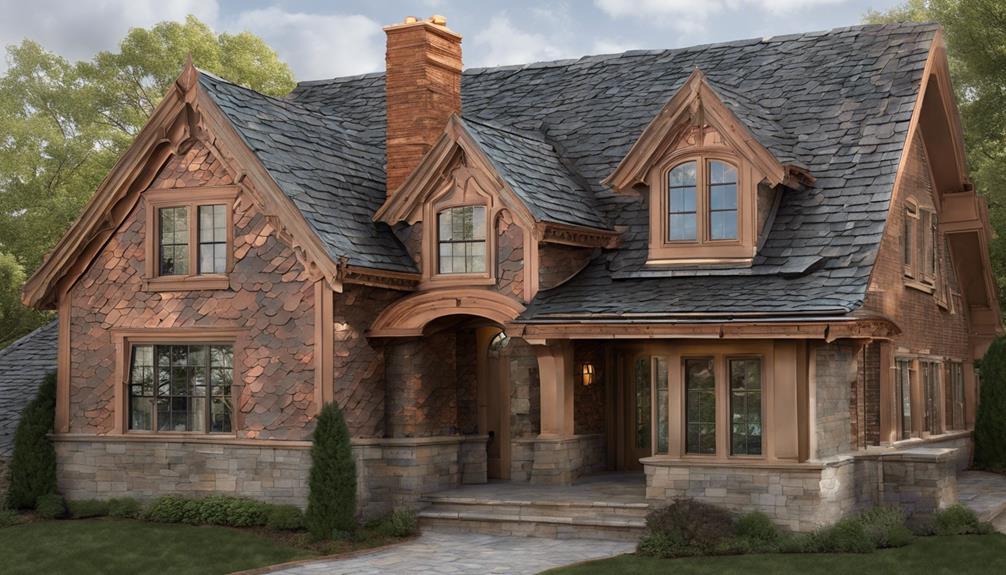
In the realm of historical architecture, the roofs of yesteryears symbolize more than just overhead protection; they embody a connection to our past and a reflection of craftsmanship long forgotten.
As we journey through the landscape of roofing materials used in 1900, we uncover a tapestry woven with wood, clay, slate, metal, and asphalt. Each material tells a story of resilience and tradition, offering a glimpse into a world where authenticity and sustainability reign supreme.
Join us as we unravel the secrets of these historic roofs, where every tile, shingle, and slate holds a piece of history waiting to be discovered.
Key Takeaways
- Preserve authenticity by using clay tiles, slate, wood shingles, or metal roofing.
- Understand historical context for accurate restoration of early 1900s buildings.
- Consult experts to match roofing materials with architectural styles of the era.
- Follow preservation guidelines to showcase construction techniques and cultural significance.
Overview of Historic Roofing Materials
In the realm of historic roofing materials in 1900, a diverse array of options like clay tiles, slate, wood shingles, and metal roofing prevailed, marking an era of evolution and craftsmanship. Clay tiles, known for their durability and distinctive appearance, were a popular choice for roofing material in historic buildings. Slate, prized for its elegance and longevity, adorned many roofs of the time, adding a touch of sophistication to American buildings. Wood shingles, with their rustic charm and natural appeal, were commonly used in the countryside, blending seamlessly with the landscape. Metal roofing, a versatile option gaining popularity, offered strength and resilience to withstand the elements.
Craftsmanship played a pivotal role in the installation of these roofing materials, with meticulous attention to detail and expert knowledge of preservation treatments ensuring the longevity of historic roofs. Understanding the craft practices involved in handling these materials was crucial for maintaining the authenticity and charm of the historic buildings. The diverse range of materials used in 1900 reflected the rich heritage and architectural diversity prevalent in American buildings during that time, showcasing a blend of functionality and aesthetics.
Importance of Preserving Historic Roofing

Preserving historic roofing materials from the early 1900s embodies a commitment to safeguarding the architectural legacy and cultural significance of our heritage. When we prioritize the preservation of these roofs, we aren't just maintaining old structures; we're ensuring that the stories and craftsmanship of the past aren't lost to time.
Here are four reasons why preserving historic roofing is essential:
- Maintaining Authenticity: Historic roofing materials help maintain the authenticity of buildings from the early 1900s, allowing us to experience architecture as it was intended.
- Showcasing Construction Techniques: These materials reflect the construction techniques of the time, providing insights into the craftsmanship and skills of earlier builders.
- Preserving Cultural Significance: By conserving historic roofs, we contribute to the overall historical integrity and cultural significance of structures built around 1900.
- Appreciating Design Evolution: Understanding and conserving these materials allow for a deeper appreciation of architectural heritage and the evolution of design over time.
Common Roofing Materials in 1900
Exploring the roofing landscape of 1900 unveils a rich tapestry of materials that shaped the architectural identity of that era. This landscape encompassed wood shingles, clay tiles, slate, metal roofs, and asphalt shingles. Wood shingles, prevalent in rural areas, not only provided a traditional appeal but also were easily accessible.
Clay tiles were sought after for their durability and Mediterranean-inspired aesthetic, adding a touch of elegance to rooftops. Slate roofs, commonly found in the northeastern U.S., stood out for their longevity and timeless charm.
In 1900, metal roofs crafted from lead, copper, or tin gained popularity due to their durability and exceptional fire resistance, offering peace of mind to homeowners. Each material carried its own unique characteristics, contributing to the diverse architectural styles and preferences of the time. This created a mosaic of roofing options that reflected both practicality and aesthetics.
Techniques for Restoring Historic Roofs

Restoring historic roofs demands a meticulous approach that honors the original materials and craftsmanship while prioritizing historical accuracy and preservation. When undertaking the restoration of a historic roof, several key techniques should be considered to ensure an authentic and accurate restoration process:
- Understand the Historical Context: Delve into the historical context of the roof's construction to grasp the techniques and materials used during that time period.
- Document Before Restoration: Proper documentation is crucial before commencing restoration work to preserve the historical integrity of the roof for future generations.
- Replicate Traditional Techniques: Skilled roofers should replicate traditional techniques to maintain the authenticity of the historic roof, ensuring that the craftsmanship remains true to its origins.
- Follow Preservation Guidelines: Adhere to preservation guidelines provided by historical organizations to guarantee the accurate restoration of historic roofs, respecting the historical significance of the structure.
Tips for Choosing Authentic Roofing Materials
In selecting authentic roofing materials for historical restoration projects, a thorough understanding of the materials used in the early 1900s is essential to ensure historical accuracy and preservation. To assist in choosing the right materials, consider the following tips:
| Authentic Roofing Materials | Tips for Selection |
|---|---|
| Clay Tiles | Check regional preferences and availability in 1900. |
| Slate Shingles | Research historical documents for accurate sourcing. |
| Wood Shingles | Consider preservation guidelines for authentic replicas. |
| Metal Roofing | Consult experts to match materials to architectural style. |
Frequently Asked Questions
What Roofing Material Was Used in 1900?
In 1900, a variety of roofing materials were commonly used. Wood shingles were favored for their availability and timeless look. Clay tiles, especially in Mediterranean-inspired architecture, were prevalent.
Slate roofs, a premium choice, boasted durability and elegance. Metal roofs, like lead and copper, were chosen for their longevity and weather resistance. Each material had its unique benefits, catering to different needs and architectural styles during that period.
What Were the Types of Roofing in the 19th Century?
In the 19th century, various roofing materials adorned buildings. Wood shingles, clay tiles, slate, and metal roofs were common choices.
Wood shingles were prevalent in wood-rich areas, while clay tiles offered a distinct aesthetic. Slate, though rare, stood out for its durability and elegance. Metal roofs, crafted from lead, copper, and tin, provided enduring protection.
These materials reflected both practicality and style in the 19th-century construction landscape.
What Is the History of Roofing Materials?
We've delved into the history of roofing materials, uncovering a tapestry of evolution. From ancient thatch to modern asphalt shingles, each era has left its mark.
Understanding this journey offers a window into human ingenuity and architectural progress. Our exploration reveals how materials like wood, clay, slate, and metal have shaped civilizations, with regional nuances reflecting diverse traditions.
The history of roofing materials is a testament to our adaptability and creativity throughout the ages.
What Were the Ancient Roofing Methods?
Ancient roofing methods varied across civilizations and regions. Thatch, wood, clay, stone, slate, and tiles were commonly used materials for roofing structures.
Thatched roofs dominated Western Europe before wooden shingles gained popularity. The ancient Greeks, Romans, and Chinese utilized slate, tile, and clay for roofing purposes. King John of England even promoted the use of clay roofs during his reign.
The evolution of roofing materials reflects the ingenuity and adaptability of past societies.
Conclusion
As we journeyed through the past and explored the diverse array of roofing materials used in 1900, we uncovered a treasure trove of history and craftsmanship that continues to inspire us today.
Like a patchwork quilt of tradition and innovation, these materials weave together the stories of our ancestors and the enduring beauty of historic homes.
Let's embrace the legacy of our roofs, preserving their charm and character for generations to come.
- About the Author
- Latest Posts
Introducing Ron, the home decor aficionado at ByRetreat, whose passion for creating beautiful and inviting spaces is at the heart of his work. With his deep knowledge of home decor and his innate sense of style, Ron brings a wealth of expertise and a keen eye for detail to the ByRetreat team.
Ron’s love for home decor goes beyond aesthetics; he understands that our surroundings play a significant role in our overall well-being and productivity. With this in mind, Ron is dedicated to transforming remote workspaces into havens of comfort, functionality, and beauty.
-

 Vetted2 days ago
Vetted2 days ago15 Best Printers of 2024: Top Picks and Expert Reviews
-

 Vetted4 days ago
Vetted4 days ago15 Best Tile Sealers for Long-Lasting Protection and Shine
-

 Vetted1 week ago
Vetted1 week ago15 Best Smelling Floor Cleaners That Will Leave Your Home Fresh and Inviting
-

 Vetted6 days ago
Vetted6 days ago14 Best Power Scrubbers for Showers That Will Transform Your Cleaning Routine
-

 Mardi Gras Decoration23 hours ago
Mardi Gras Decoration23 hours agoWhat Do the Symbols of Mardi Gras Mean?
-

 Appliances4 days ago
Appliances4 days ago5 Best Energy-Efficient Stainless Steel Fridges 2023
-

 Vetted4 weeks ago
Vetted4 weeks agoBest Mop for Sparkling Clean Floors in 2024
-

 Vetted4 days ago
Vetted4 days agoBest Essential Oil Brand: Top Picks for 2024




























